Introduction
Nine years ago, a hike through British Columbia’s West Coast Trail (WCT) left me battered, bruised, missing toenails, limping and using trekking poles as crutches. During the first five kilometers of the trip, I slipped and fell resulting in a sprained ankle, and unbeknownst to me, a stress fractured metatarsal. After 71 kilometers of limping through mud and tree roots, I had developed permanent nerve damage. To this day, the limp is still present, and a high-mileage trek can bring excruciating pain to the surface. Now almost a decade later, my friends convinced me to return and hike this bucket-list trail. I surprised myself by agreeing to the 76-kilometer venture.
The West Coast Trail and I are on a collision course for a rematch.
A decade ago, I paid minimal attention to pack weights. I was young, muscular and naturally athletic, which carried me through backpacking. Though most would argue I am still all of those things, I need to plan with more care now. In addition to watching my ounces for my nerve damaged foot, I must pay close attention to how much stress I place on upper body joints and ligaments (see My Journey from Injury to the Canadian Rockies for details.)
Trip Logistics
Planning and Preparation
- The WCT requires strong planning skills. Transportation to Vancouver Island is necessary, and the trailheads can be challenging. Almost all transportation needs advanced booking or flex days included in the itinerary. The trail requires a permit. Book permits well in advance, or they will be sold out. (I booked in January of 2016 for my hike in September of 2016.)
- Parks Canada provides an updated planning guide each year. (WCT Planning Guide)
- The book, Blisters and Bliss, Trekkers Guide to the West Coast Trail, is an invaluable resource which is updated by the author semi-regularly, if not annually.
Travel Style
- The West Coast Trail 2016 is a team trip. Gear sharing and team planning are crucial. The WCT requires heading out with companions with similar trekking style and speed. For this trip, I’m heading out with some good friends. We’ve done long treks together before and never shared so much as an irritated glance between us.
Logistical Notes
- Travel to Vancouver Island is the most difficult logistical challenge. The island is reachable by ferry, bus, private vehicle and or plane.
- We will fly into the nearest airport and bus from the nearest terminal to the trailhead.
- As we are flying, we will be unable to travel with items like fuel. I will order a hiker box from the local outfitter.
- Clean up gear for the return flight (the other passengers appreciate it). Clean clothes and toiletries can be left with the bus company for a fee.
Equipment Notes
- The western edge of BC’s Vancouver Island is a coastal rainforest: saying the area is “damp” is an extreme understatement. In September, weeks of rain can be expected. Footing on this trail is treacherous at best – a slip and fall can be wet and unpleasant or painful and deadly. I recommend a synthetic sleep system, quick-dry layers, a wind- and rain-resistant tent, and footwear that provides stiffness and traction for edging on steep, wet, and muddy terrain. Although not ultralight, most experienced users of the trail wear a proper hiking boot, gaiters, full rain gear, and river crossing shoes.
- The trail has up to seventy sections of wooden-laddered cliff faces. Some laddered sections are close to a hundred feet in height. The rainforest and the Pacific Ocean have frequently attempted to reclaim the trail. Though a maintained trail, trail damage is common. In some areas, the damage creates unsafe conditions, so your footwear choice is of utmost importance.
- Approximately 8000 hikers a year attempt the trek. Eighty to 100 backpackers will be medically evacuated, and 200 will sustain injuries. Ropes and other safety equipment are sometimes found on the trail but are not maintained. Be prepared to test any equipment and come up with an alternate technique for climbing difficult sections. Many trail users recommend a heavy length of climbing rope, especially if attempting difficult surge channels and beach crossings.
- Bears, cougars, and other wildlife frequent the trail and proper techniques for bear country are mandatory. The trail offers food storage lockers, but they can be full during peak season. Be prepared to bring a bear bag or canister if traveling during peak season.
Photo Journal
Murphy’s Law
When September 17, 2016, finally arrived, I was a frantic mess of last minute details and snags. Despite an overwhelming craving to cancel the trip, I knew I needed a vacation from my life and the inordinate ongoing pressures. A family emergency and heavy workload seemed to eat up all the time I thought I had left to finish all the last minute planning details. Thank goodness, true to my word in my best practices article; though harried and frayed, I had the major details worked out. The only planning steps left: a meal plan, quick pack stuffing, and some optional bookings.
My friends arrived at just after 7 am to pick me up, and I knew we were going to be pushing time limits. There was nothing any of us could do about it except grin, bare it and hope for the best at the airport. Once at the airport, we struggled to find parking, a detail I had neglected to arrange in the chaos which had been my life for several weeks. Arranged parking can save a few dollars and a few minutes when time counts. As it happened, booking parking could not have prevented us from a near catastrophe.
Best Laid Plans
After rushing to the airport and standing in the check baggage line, we were five minutes too late to check any bags. I could get on the plane if I left my gear behind. My team exchanged glances, and we knew there was no point getting on a plane without gear. Thank goodness for West Jet’s wonderful service team. The baggage check attendant rebooked us for a flight leaving for Comox, BC, Canada. The flight was boarding ten minutes later than our current flight to Nanaimo, BC, Canada which still had time to check baggage. She didn’t charge us a dime for the flight change, and we solved one minor snag of many to follow.
Getting us and our gear to Vancouver Island was helpful. However, we would land in the wrong city. Having enough time to pick up supplies and get to our bus on time was going to be an issue. The bus was departing from Nanaimo at 2 pm, and we were landing in Comox (an hour and a half from Nanaimo) at 11 am. We needed a rental car and needed one fast when we landed. I have never bailed out of a plane so fast in my life! I ran across the tarmac to the rental car kiosk. If I wasn’t one of the first in line for a rental car, we might miss the bus. We also had to face reality; we may not be able to obtain our box of supplies in time.
Hop, Skip and a Jump
As fate would have it, I made it to the kiosk second in line. I sighed with relief, and we loaded our gear into the last remaining SUV. I had ordered a hiking box of supplies, but we were well out of the way to pick it up at Valhalla Pure Outfitters in Nanaimo. After some Google Map searching, we found a Valhalla Pure in Courtney, BC which had the supplies we needed and was directly on our route. Next door to the Valhalla, we found a Canadian Tire which had the remainder of the supplies we needed.
We actually made it to Nanaimo with time to spare! After grabbing a quick lunch and dropping the rental car off, the staff at the rental car agency was able to drop us off at Departure Bay Terminal. When the bus arrived, I sank into the seat with a sigh. The details were mostly handled from this point forward.
The scenic bus terminal in Departure Bay. The West Coast Trail, Canada’s Wild Coast (below).

All around Departure Bay there are signs of industry and transport (above).
The Wheels on the Bus…
The bus ride is several hours through rough, winding, logging roads. I was thankful I had remembered to take some Gravol (nausea relief) before I climbed aboard. By the time we all staggered off the bus, we were all grateful for solid ground.
In addition to not booking parking, I also did not book accommodations at the trailhead. I should mention here that accommodations are mandatory if you arrive at the trailhead after 2 pm. To hike the WCT, every hiker is required to attend the orientation at the trail office at 10 am or 2 pm. Mandatory attendance is easy for the Parks Canada Staff to enforce. If you don’t go to orientation you won’t get a trail permit. Without a permit, a ferryman will not take you to the trailhead.
The WCT Office is about a one hour walk to the edge of the nearest town, Port Renfrew, BC. Five minutes away is the Pacheedaht First Nations Campground. Having stayed at the beach here in 2006, I wanted to camp here again. Prices are reasonable, and in late September there are usually enough campsites, but it was something of a gamble not to book in advance.

Above: After several hours on a plane, in a rental car and eventually a bus, I finally reached my beloved West Coast Ocean Vista at Pacheedaht Campground, Port Renfrew, BC, Canada.
Wild Renfrew
As it happened, my gamble paid off and I got a spot near the ocean. Once we had set up camp and changed into some rain layers, it was close to 7 PM. With a lack of motivation to cook, we opted to hike into Port Renfrew for dinner. After an hour of trekking along the narrow logging road into Port Renfrew, we reached the edge of town. Forty-five minutes later, we walked into the heart of town. From there, we walked to the best restaurant in town: The Coastal Kitchen. We all knew it was going to be a long couple of days before we would have hot, fresh food and a fresh gourmet pizza was impossible to resist.
Welcome to the Coast
We order a Big Kahuna pizza and the specialty ice tea and wait for what I describe as the best pizza I have ever had in Canada. While we are eating, we are reminded we are in the middle of the rainforest in a remote coastal town. Torrential rains pound on the tin roof of The Coastal Kitchen. I exchange glances with my companions. We have rain gear, but two hours of hiking back to our tents in the pouring rain and pitch-dark night on a narrow coastal road is unappealing.
I call the server and ask if there is a cab in town who might be willing to take us back to Pacheedaht.
Her: “A cab? No. Well, there is Evan.”
Me: “Evan?”
Her: “Evan, he runs the hiker parking lot at the trailhead, but he only helps hikers.”
Me: “We are hikers, we start tomorrow.”
She smiles and says she’ll call him. “Yup, they are hikers.” I overhear her say from the kitchen. Although Evan’s service has closed for the season, he will pick us up anyway.
A Short Trip Down a Long Road
A few moments later, Evan pulls up in front of The Coastal Kitchen. We scurry from underneath the awning through the blinding rain and climb into the exceptionally clean interior of a well used but serviceable minivan. Evan looks back at us and says “Mind the back seat; I just had it cleaned and took the hiker tarps out.”
“Good news! We haven’t started hiking yet,” I reply.
Evan eyes our damp but clean clothes and says, “Best news I’ve had all day.”
Evan says if we had been fishermen he would have left us to walk. In his experience, the entitled fisherman in the area cause issues, but he likes hikers. Hikers appreciate the local help.
On the drive back to Pacheedaht, I talk with Evan to obtain trail information he knows from talking to backpackers all summer. Evan’s trailhead parking lot has been empty all week, but today it filled up.
When we arrive at Pacheedaht, we pay Evan and leave a good tip for coming out this late at night in the rain to bring us back. We scramble from the van and stumble our way through the narrow dark paths to our dry and waiting tents.
 As wet and cold as the Pacheedaht campground was, my Above: Nemo Equipment Blaze 2P tent was warm and dry after sitting out in the sustained rain for several hours.
As wet and cold as the Pacheedaht campground was, my Above: Nemo Equipment Blaze 2P tent was warm and dry after sitting out in the sustained rain for several hours.
Once I settled into my tent for the night, I am disturbed to find that I’m camped next to a large group of partying surfers. I put in my earplugs and wait several hours for some peace. Not even the pouring rain and ocean waves can drown out a stereo that loud. So much for an early bedtime.
An Early Morning
With dawn, my morning begins and I realize I didn’t plan a breakfast for this morning. I was able to scrounge some plain tortillas and cheese out of my meals. It is not gourmet, but it beats being hungry. I thank my lucky stars; I usually have a few extra bits and bites in my pack for emergencies.
After what I can consider breakfast, I wrap my knee for the tendonitis which has been bugging me all summer. The stiffness wears off when I use the knee, but it aches until it warms up. I pack some extra first aid supplies in case the tendonitis gets worse.
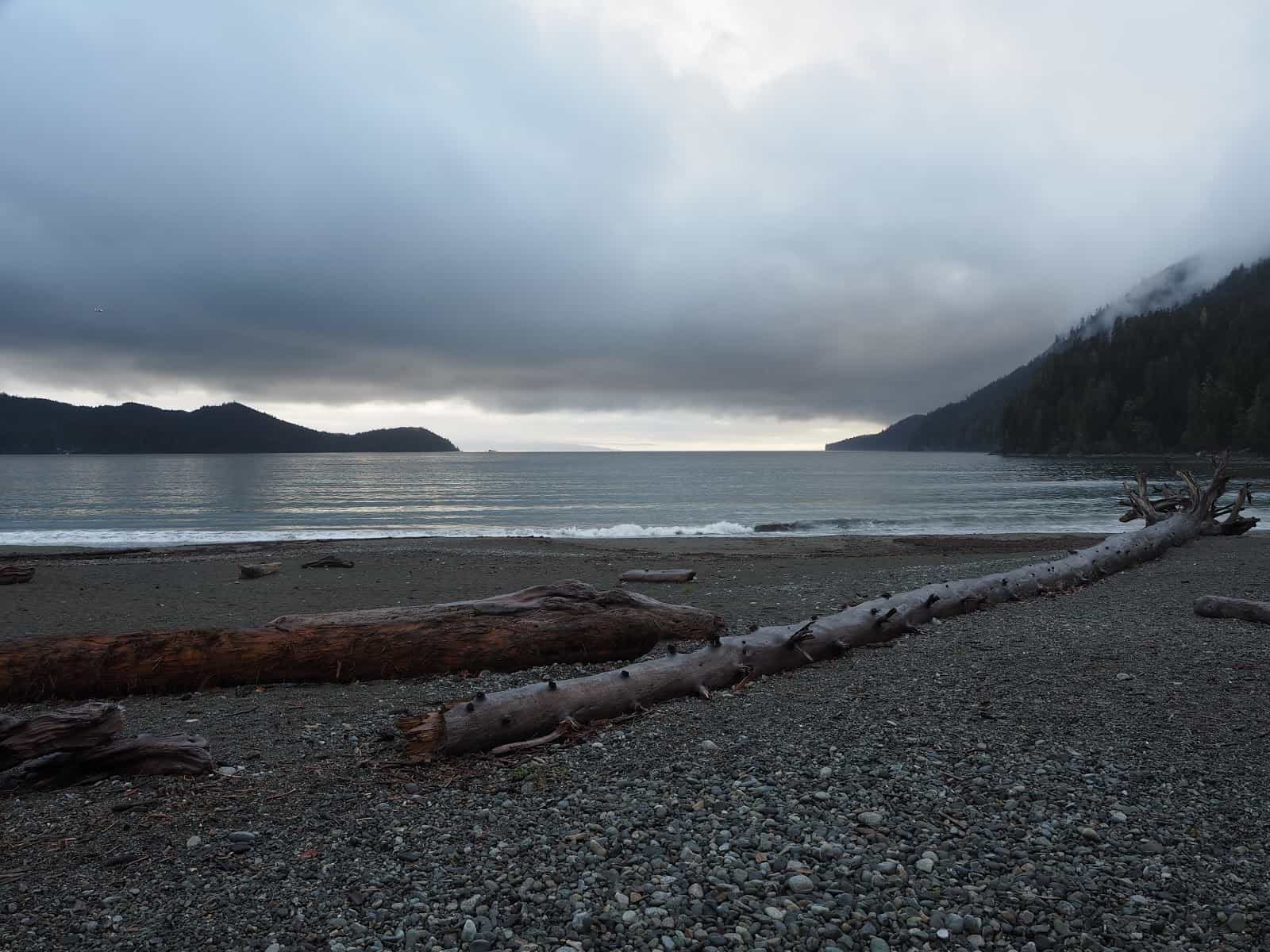 Above: I collapse my tent, pack up my gear and take a short walk up the beach. This place is as beautiful as I left it ten years ago; perhaps even more beautiful. Years of experience make me crave the simplicity of this place often. For a decade, this place, these beaches, have been the quiet place my mind’s eye goes to for an anchor.
Above: I collapse my tent, pack up my gear and take a short walk up the beach. This place is as beautiful as I left it ten years ago; perhaps even more beautiful. Years of experience make me crave the simplicity of this place often. For a decade, this place, these beaches, have been the quiet place my mind’s eye goes to for an anchor.
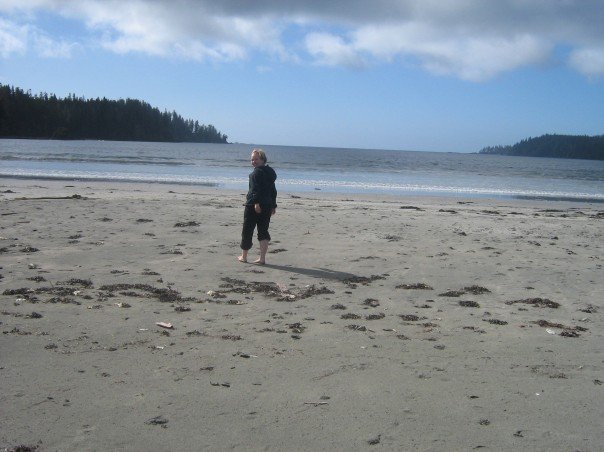
Above: I hiked here in 2007; it’s been my anchor point in stormy times in my life. During some of the worst times of my life, I have returned to Vancouver Island to refresh my memory of a place which resonated deeply with my soul. Isak Dinesen once said, “The cure for anything is salt water: sweat, tears or the sea.” For me, this remains true, and I usually seek all three in this place. – Photo 2007
And so it Begins…
We shoulder packs and trudge down the road to the West Coast Trail Office in Port Renfrew for registration and orientation. Since this trail has seen many accidents, and fatalities, every hiker is required to attend orientation. Big fines will be incurred if you are caught on the trail without a permit (the permit is also required by every ferryman on the trail). You could try to swim the channels, but I would suggest taking the ferries.
I sit through the orientation and I can only half focus. The weather is almost perfect for this trip. Fortunately, there isn’t any new information that I haven’t already learned through my research and experience here.
My mind is drawn to the location of my injury on my first trip. I sprained my ankle (third-degree sprain) and unknowingly damaged a foot bone and a nerve passage on the first day. I limped myself up the trail for the next five days, in what I call, the best-worst experience of my life. The foot still has nerve damage, and I wear prescription insoles in full trek boots to compensate for this day. The memory causes some angst.
On the trail again…
I show my permit to the ferryman; he’s a friendly but private fellow. I remembered him from my last trip.
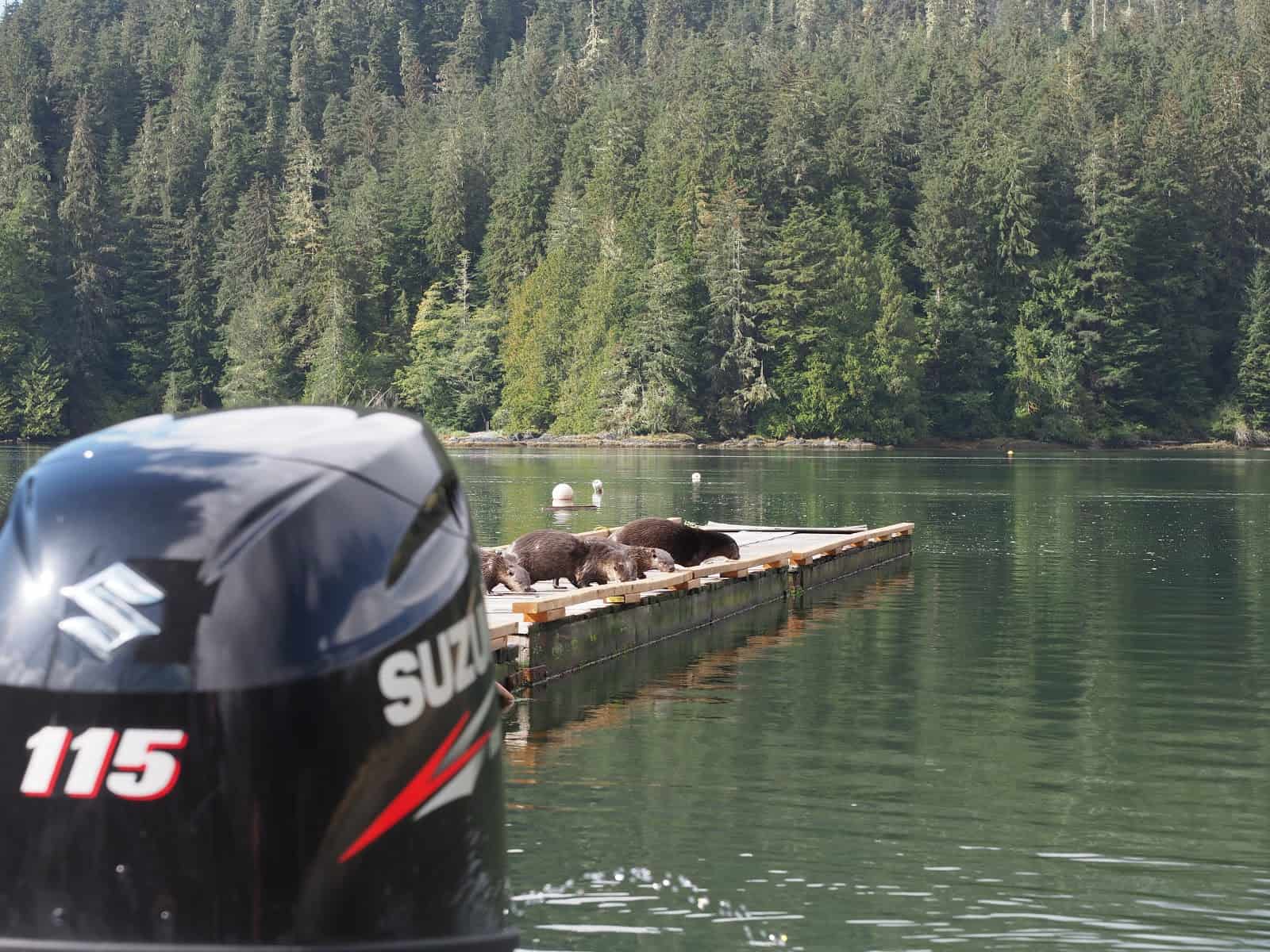
Above: Sea otters sun themselves on the dock; I barely catch a glimpse before the ferryman’s dog chases them into the water.

Above: The ferryman’s dog is charismatic and makes me wish he could come with me. I know well, the trail is impassible for his kind, but I can’t help but wish for such a stalwart companion.
Up and Away…
The Ferryman ushers us to the other side of Gordon River and then leaves us on the beach and to our own devices at the edge of Port San Juan.
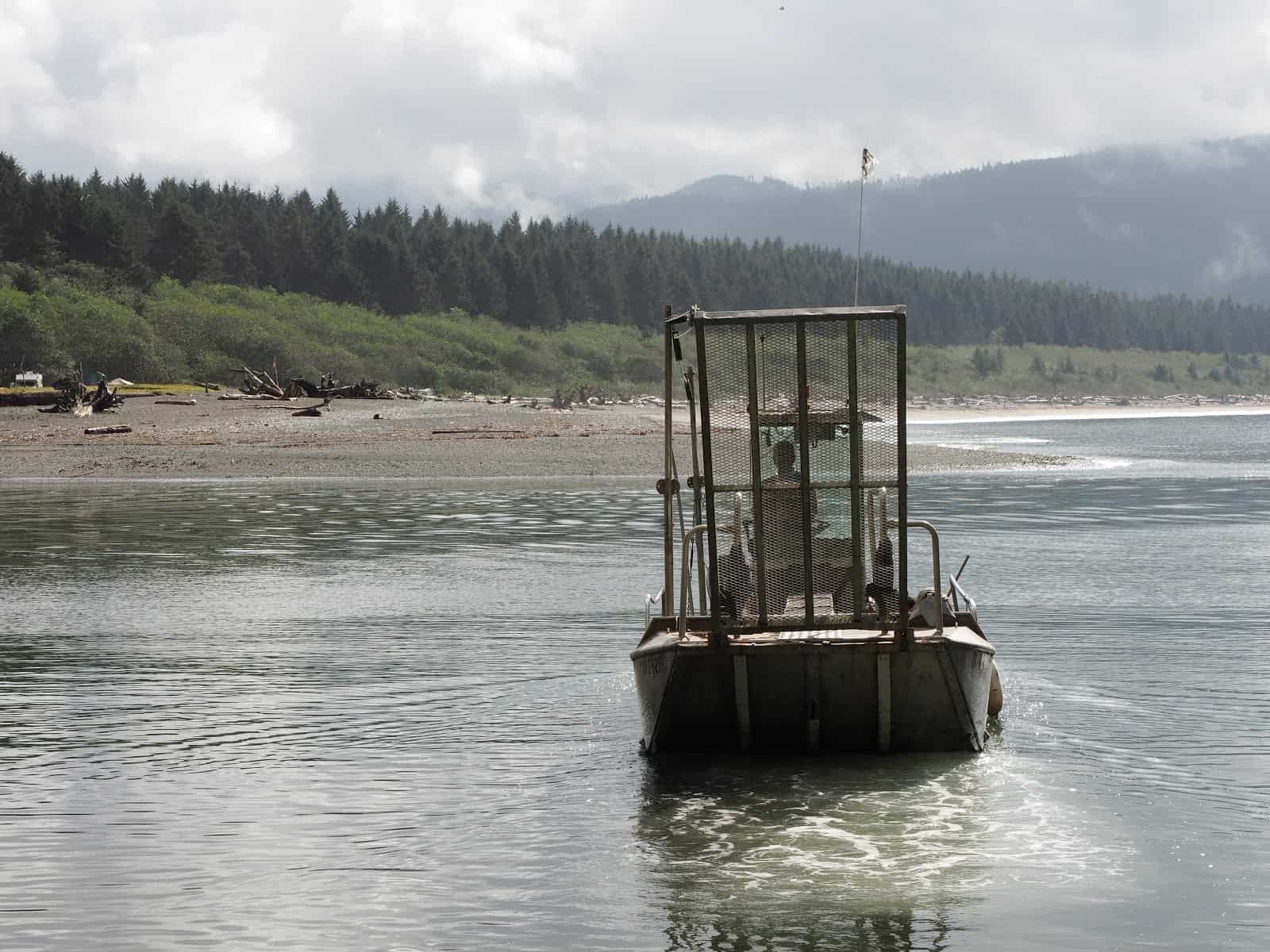
Above: The Ferryman backs the ferry away from the shore at the Gordon River Trail access point and leaves us with only one option: climb.

Above: The small beach here has a sign marking the trail and the first of many ladders. Parks Canada information and a welcome from the first nations people, the Huu-ay-ahi, Ditidaht, and Pacheedaht, welcome travelers to the trail. The first nations Trail Guardians repair and build the facilities found on the trail. Without them, the ladders, boardwalks, bridges, and outhouses would be reclaimed and destroyed by winter tides and rainforest in a matter of months.
Hello, Cardiovascular System, aka WCT Ladders
If climbing ladders doesn’t make your heart race, then looking down likely will.
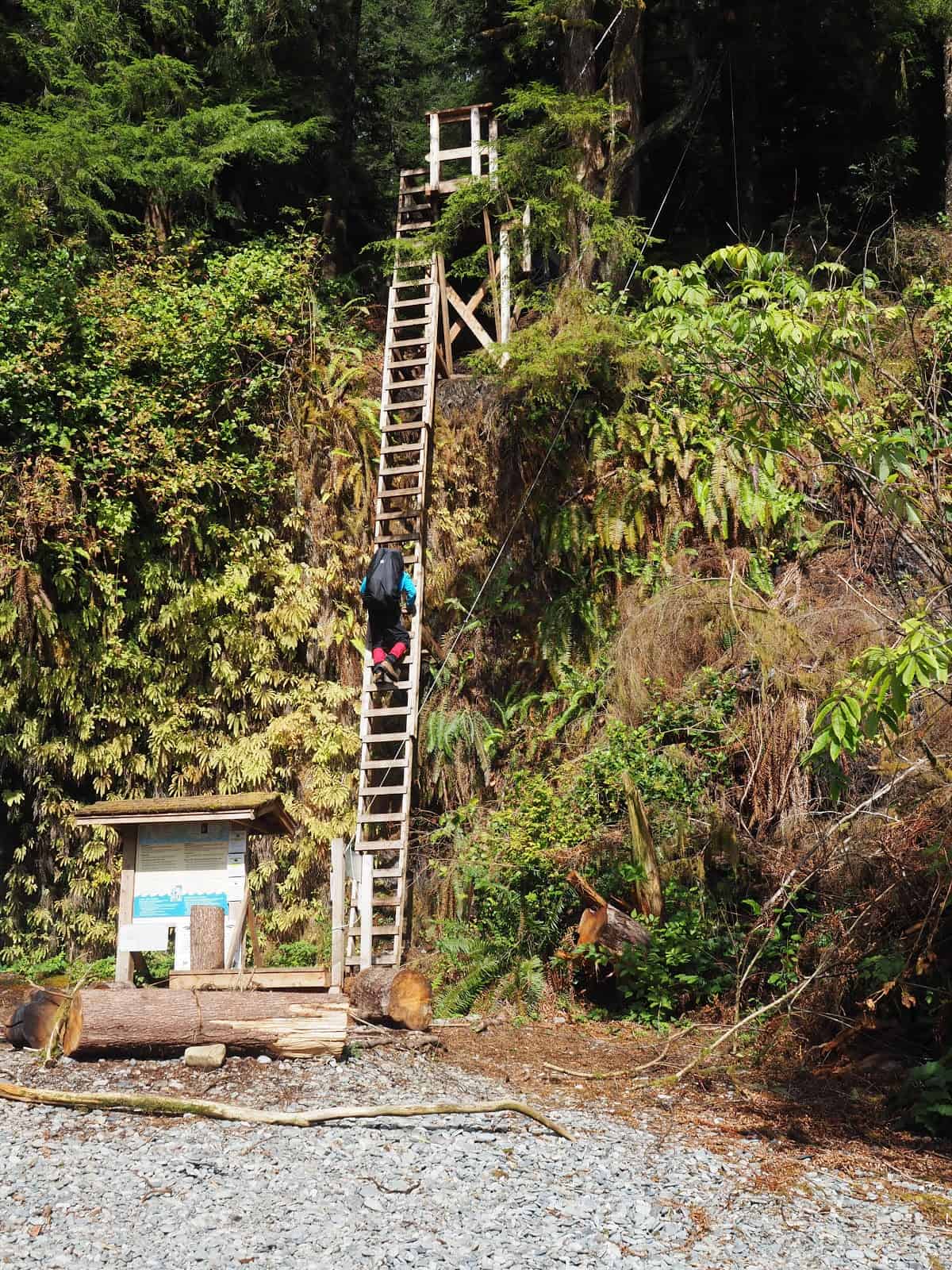
Above: My hands are shaking as I wait my turn to climb the first ladder of the West Coast Trail.
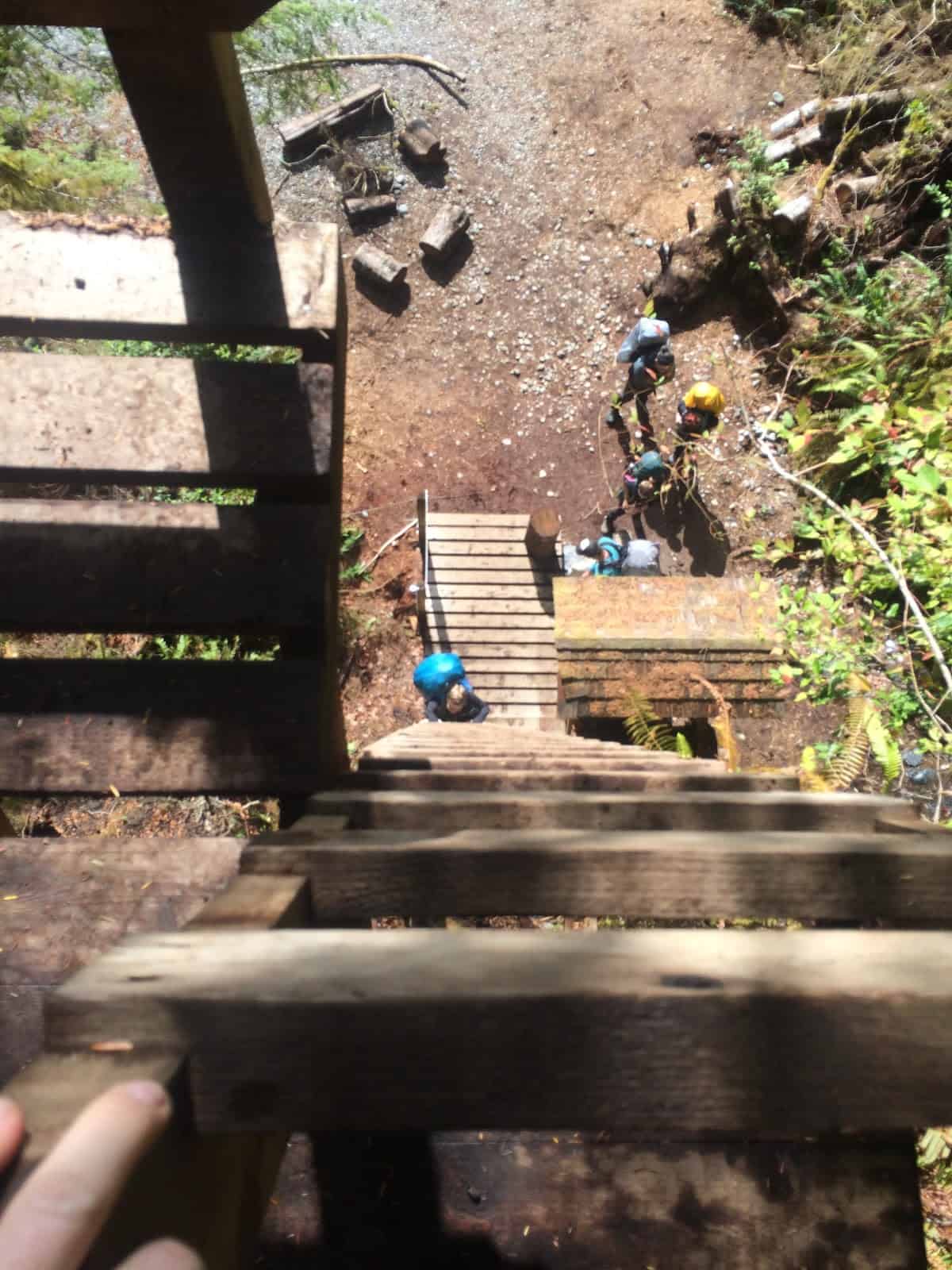
Above: I taste blood as my heart races, and blood pressure soars. I’m afraid of heights. In 2007, I did all of the ladders on this trail with my eyes closed and never looked down once.
Rules of the Rungs
The rules about the ladders here are simple:
- One person on the ladder at a time.
- A three-point touch is required on the ladder at all times.
- Do not stand directly underneath a ladder.

Above: I have a three-point touch on the ladder here, two feet and one hand; the right hand is reaching upwards for the next rung. They are wet, slippery and not frequently maintained. Be cautious; the West Coast Trail is no place for cavalier thinking.
The encroaching rainforest rusts the nails and rots the wood of structures at an alarming rate. Only one person at a time keeps the weight stress on the ladder lower. A three-point touch (moving only one hand or foot at a time while the other three stay anchored on the ladder) ensures the climber can rebalance should a rung come loose. If the climber cannot rebalance and falls off the ladder, no one aside from the climber is injured from the fall as long as no one is standing below.

Above: There is no shortage of ladders, and we have not even reached ladder purgatory at Logan Creek yet.
The First Five
The West Coast Trail has distance markers every one kilometer or so. The five kilometers from Gordon River to Thrashers Cove is the roughest and most rugged on the entire trail. This section can take up to ten hours, depending on the hiker. I am a decently fast hiker, but my trepidation about this section in light of my previous injury here, makes me obsessively watch my foot placement. In case, dear readers, you think I’m overly dramatic, please review this news article titled: How Not to Die on the West Coast Trail. It is that bad.
The trail here is heinously rough – do not underestimate it – especially if you have the misfortune of rain.
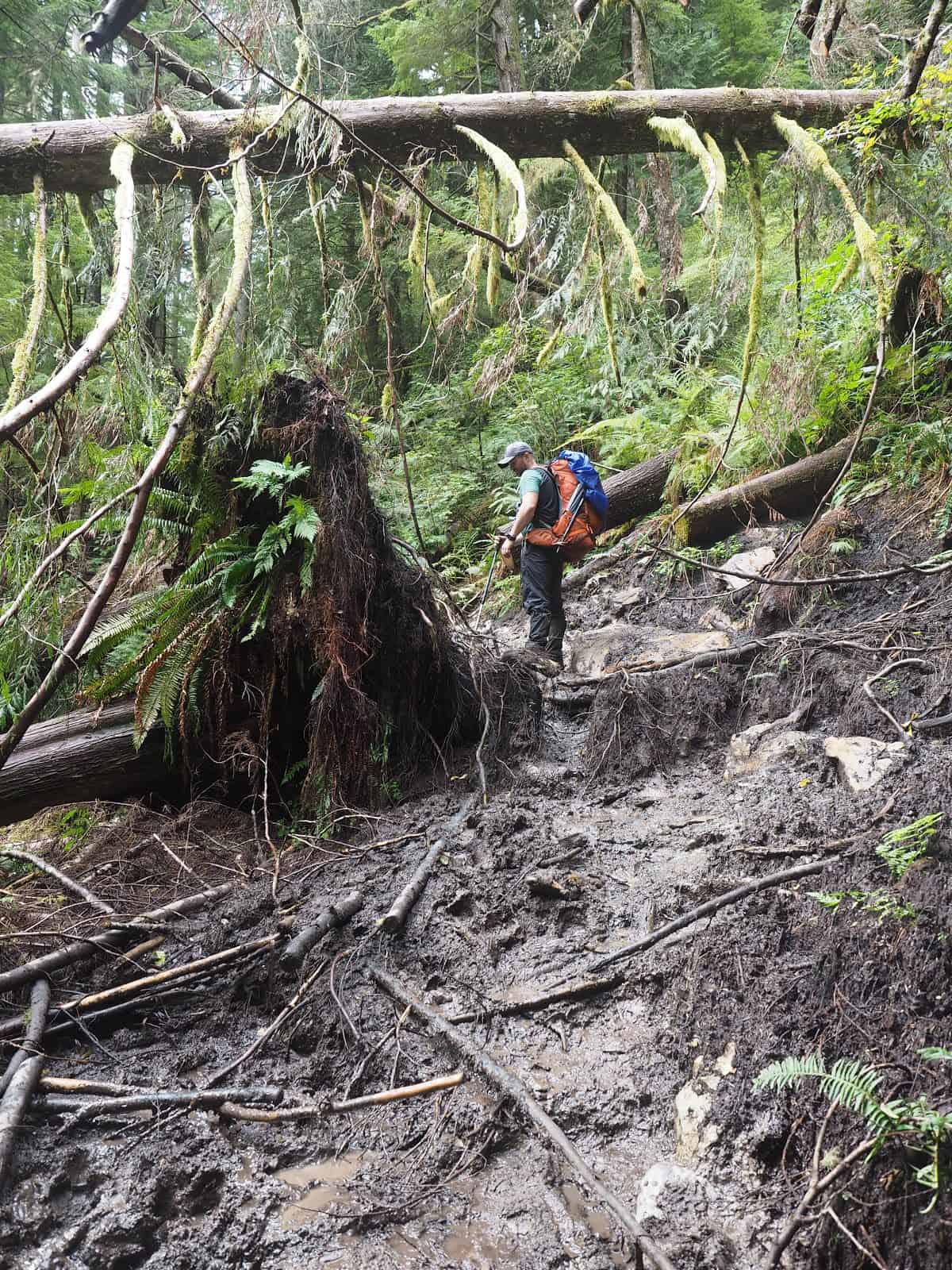
Above: Mud is plentiful on the West Coast Trail. Combine a rainforest with tidal shelf, and a game of “slip sliding away” is bound to follow. Trying to avoid the puddles by walking on their mud-fringed edges usually results in compromised footing anyway – stick to the path.
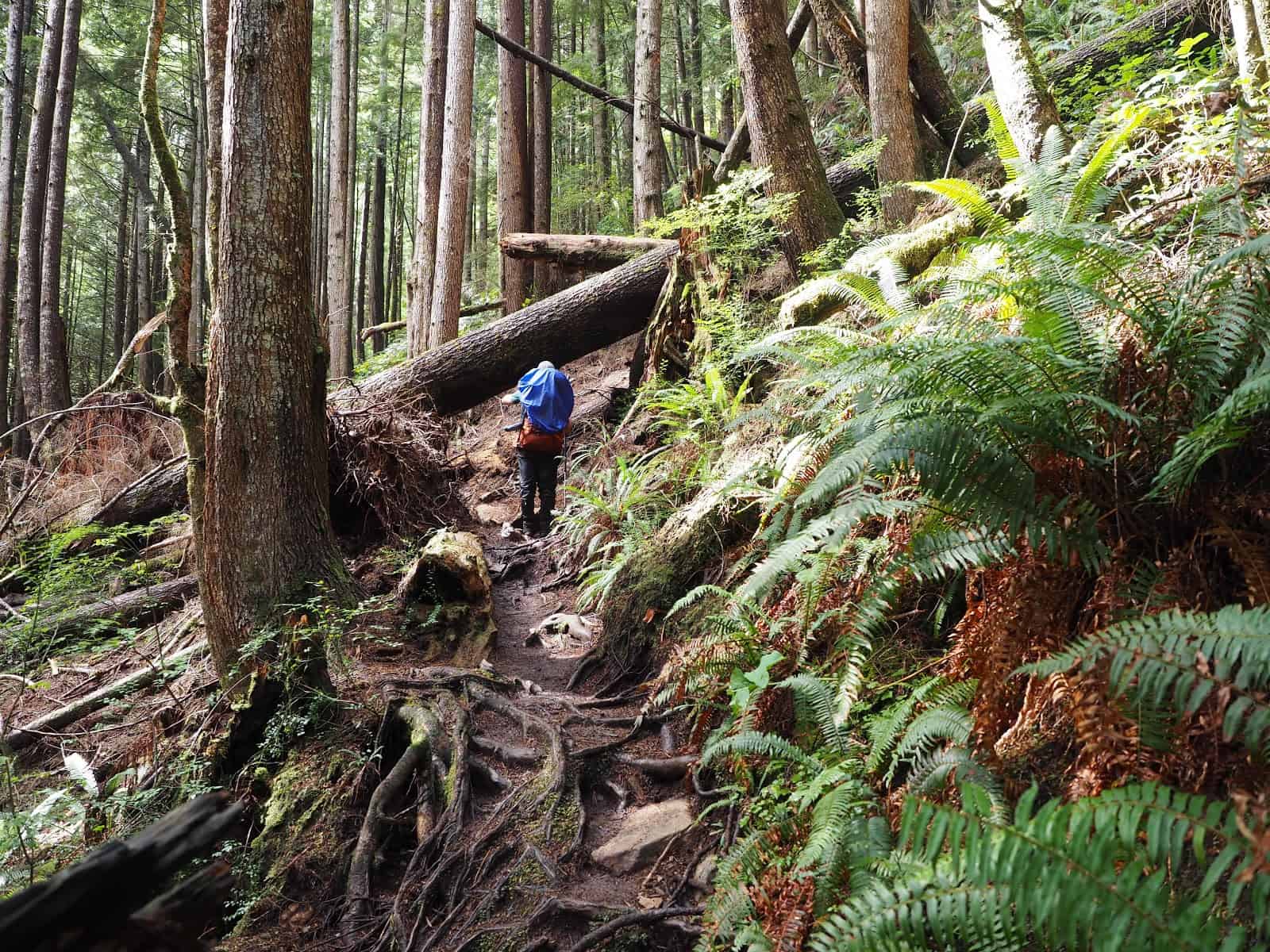
Above: Aside from mud, there is also a game of “Snakes and Ladders” climbing the extensive root system of the rainforest floor.
The Law of the Jungle
Rules of engagement for rainforest sections include:
- All wood surfaces (including roots, ladders, and platforms) are slippery.
- Rocks are most likely loose and slippery.
- Avoiding stepping in mud and water puddles is the most likely cause of a fall or injury.
In short, conduct a slip test foot placement before climbing. Don’t save your boots at the expense of soaking your pack or getting an injury. Your footwear will be wet and muddy, slog on through those puddles, fewer falls and injuries will be experienced.
Slogging Upward
The section of trail between Trail Marker 75 and Thrashers Cove is unforgiving and mentally and physically taxing. Everything about this section is technical and frustrating. Each footstep requires intention. This year I have hiked several hundred miles and still, I am struggling with the mental focus this requires. I remembered my travails through this section in 2007 – careless foot placement cost me an injury which has had long-lasting ill effects on my physical well-being.
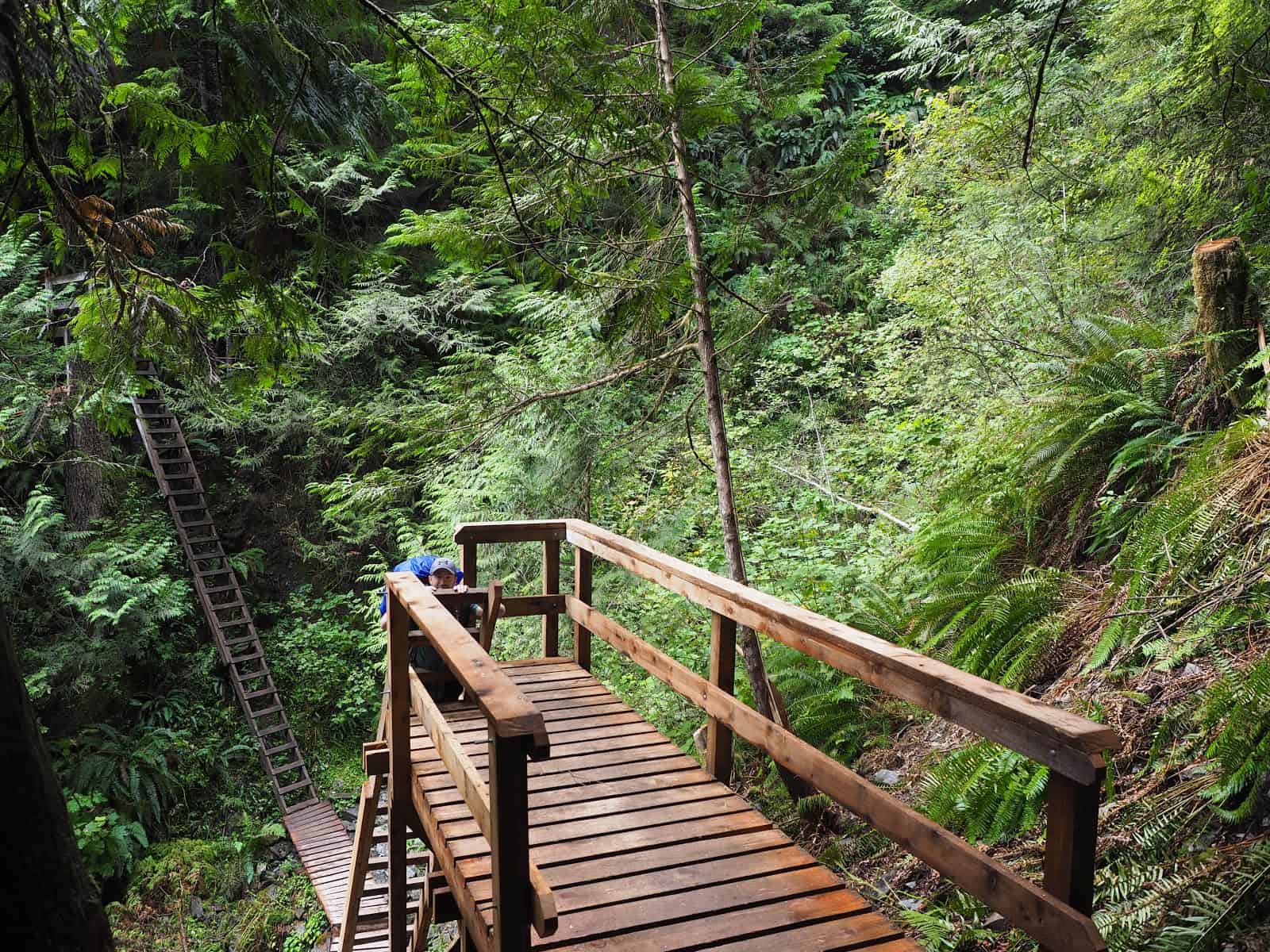
Above: The boardwalk-and-ladder terrain is undulating and rugged.
I swore I would never hike this wet, soupy, godforsaken section of the world again (at least for the first five years after 2007!) But here I am, almost wishing I wasn’t here.
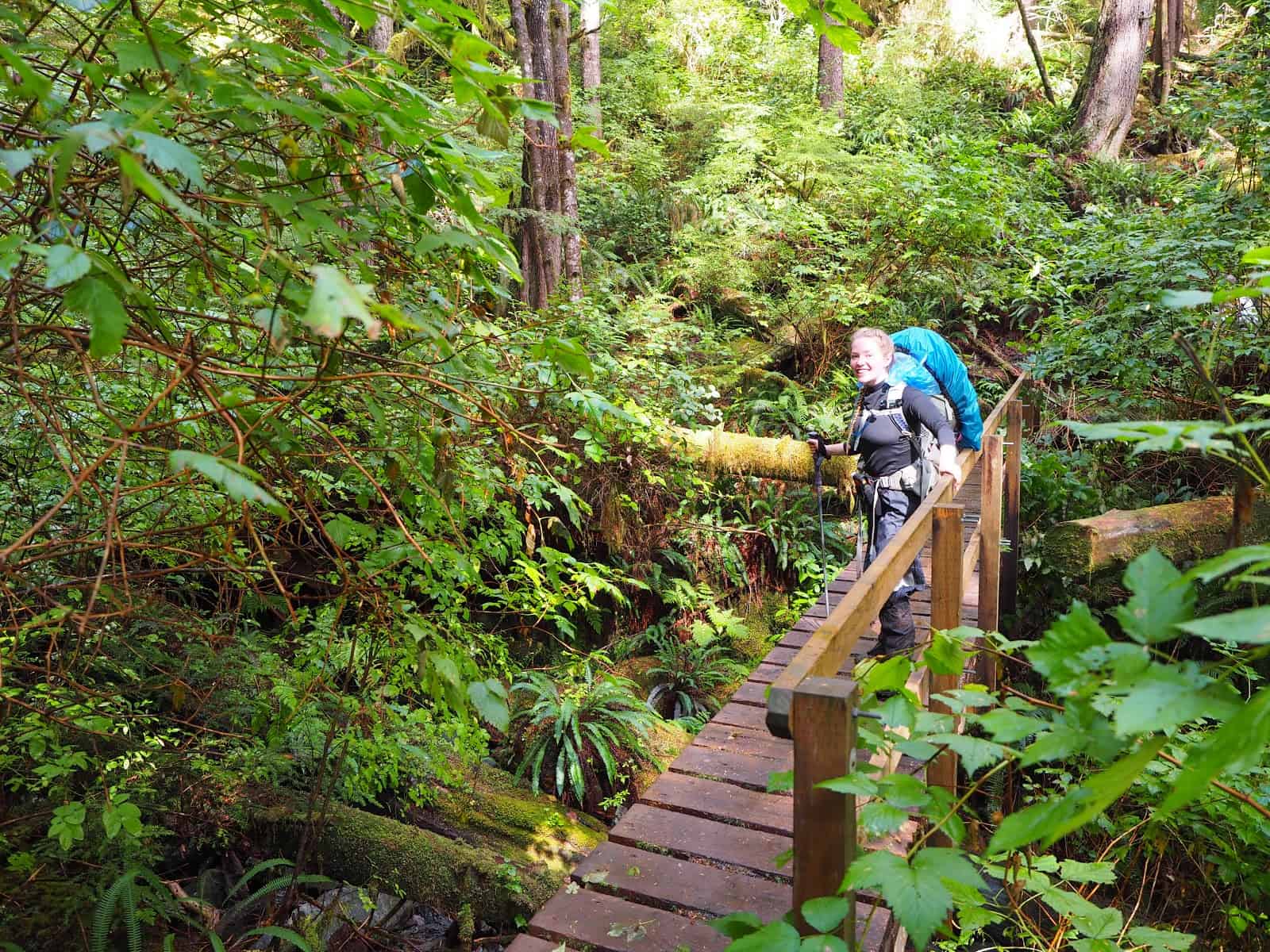
Above: There are sections of the trail which have seen some environmental improvements to prevent erosion and improve safety.
Born of Blood, Sweat, and Tears
At Marker 72, near the highest elevation on the trail, rests an old donkey engine. It’s a remnant of a bygone era of logging and steam engines; things once moved by the sweat and blood of men and horses.
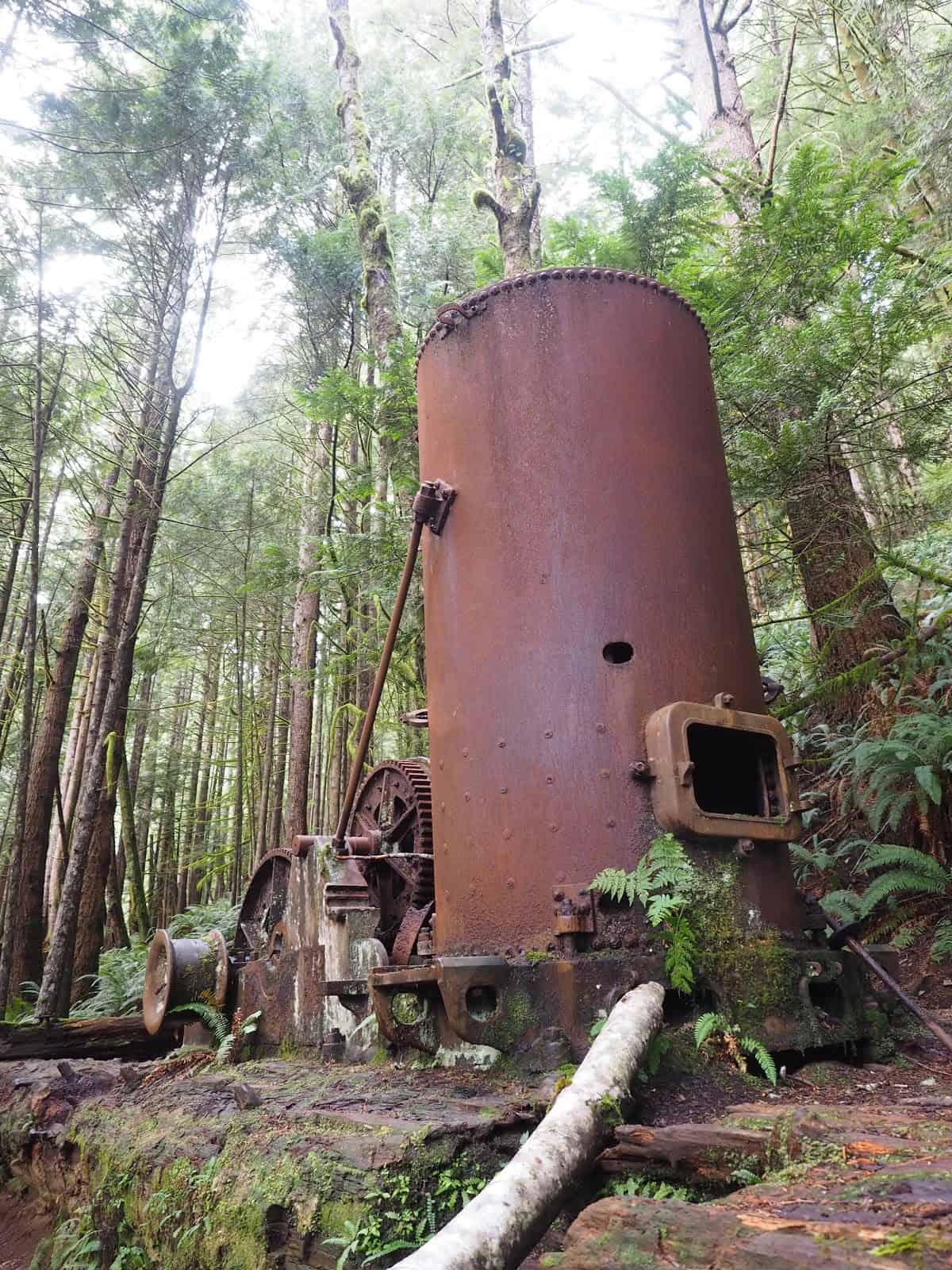
Above: The massive engine and steep incline make me think the men that moved this donkey engine were made of iron and steel themselves. I cannot even imagine the hardship it would have been to move the large metal engine. It would be a feat even today.

Above: The derelict donkey engine was a steam-driven logging force. The work here was hard and rough and shaped a country of tough, hardy people with a will for making a way into the untamed wilderness. My Grandfather ran a sawmill when I was a child. I still love the smell of wood shavings and remember the hot tea and coffee which are a part of what seems an evaporating culture in Canada.
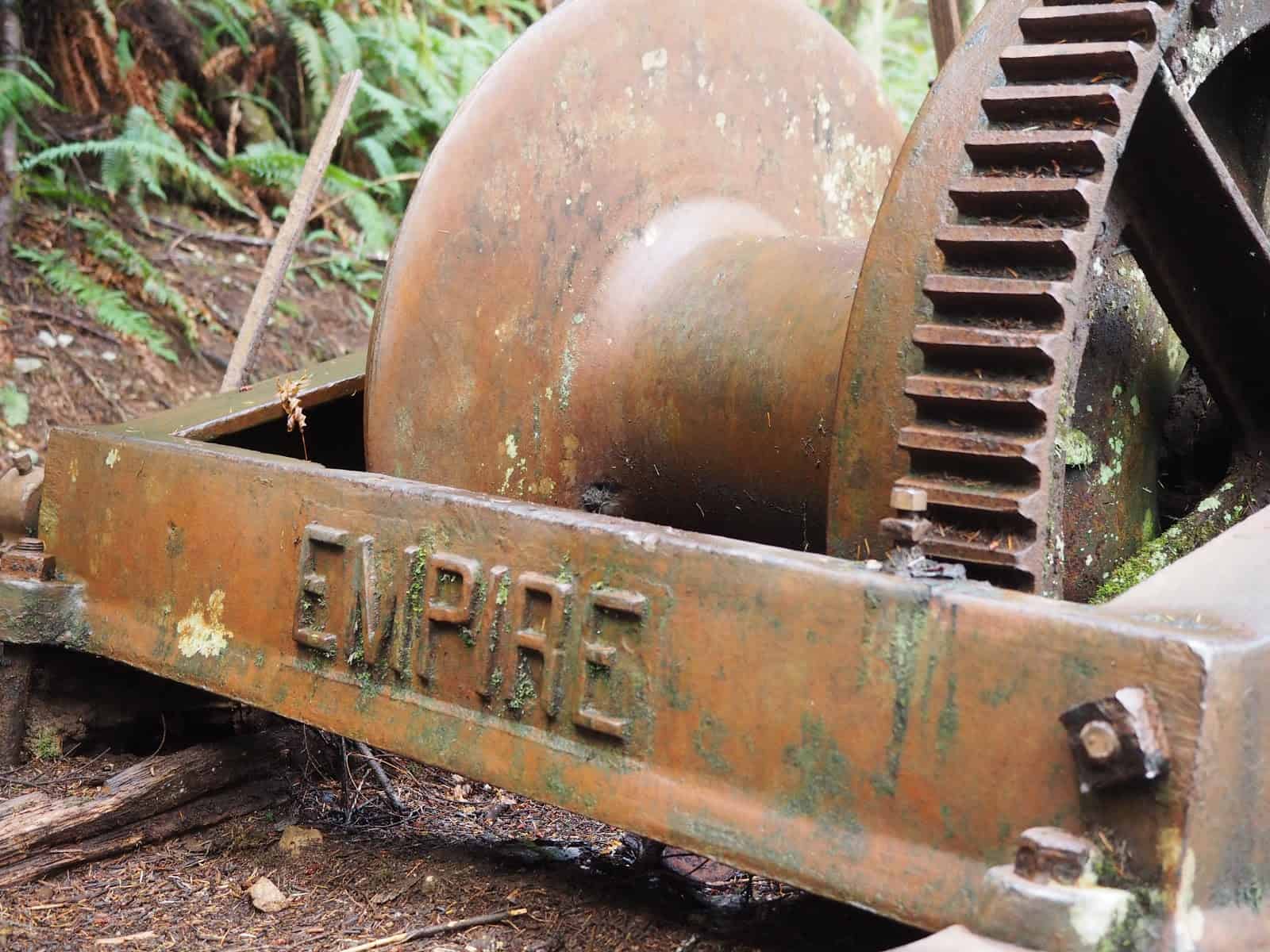
Above: Something about the history here resonates with me. Curiosity about the people who worked her compels me to explore every angle of the artifact.

Above: Now near the highest point of the trail and with the donkey engine behind me, I stop for a rest leaning against one of the forests fallen giants.
Homeward Bound
The downward spiral to Thrashers Cove finds the footing wet, slippery and gnarled with the roots of ancient standing giants. Looking up I cannot see the top of the cedars surrounding me here. I feel hemmed into the depths of the forest. Now mid-afternoon, it is humid and claustrophobically warm. I crave an ocean breeze and some cool open air.

Above: Despite the heat, I still enjoy looking at and finding banana slugs. They come in colors: black, yellow with black spots and brilliant bright yellow. There are slugs bigger than my thumb everywhere in the rainforest. I’ve heard they are edible but they don’t look particularly appetizing to me. I’ve also heard they will make your mouth go numb. Mind your hands on the ladders; you may have the misfortune of squishing one of the poor little things.
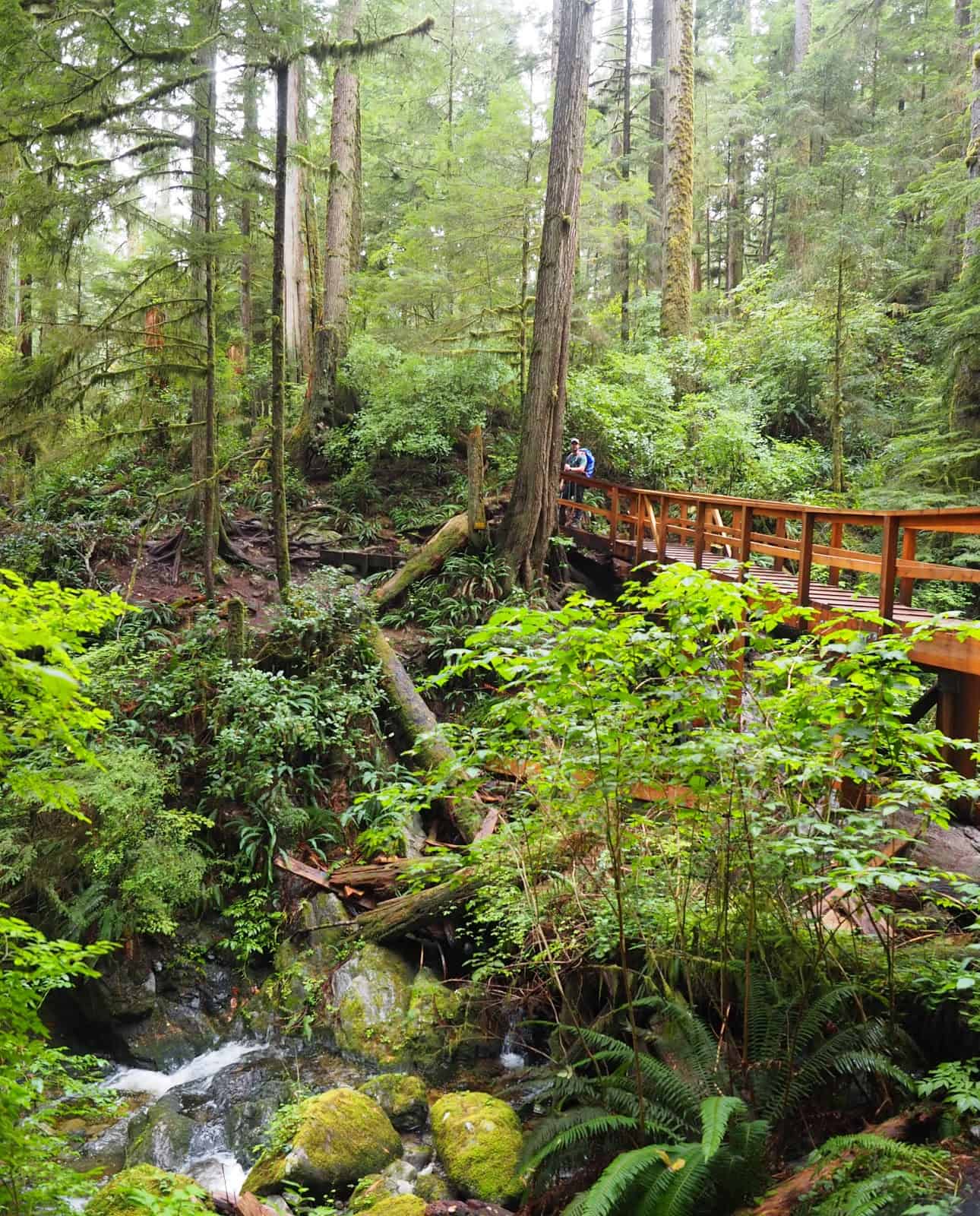
Above: The heat cannot dampen my enthusiasm. I feel much lighter, knowing that the place I injured my foot on my initial trip is far behind me.
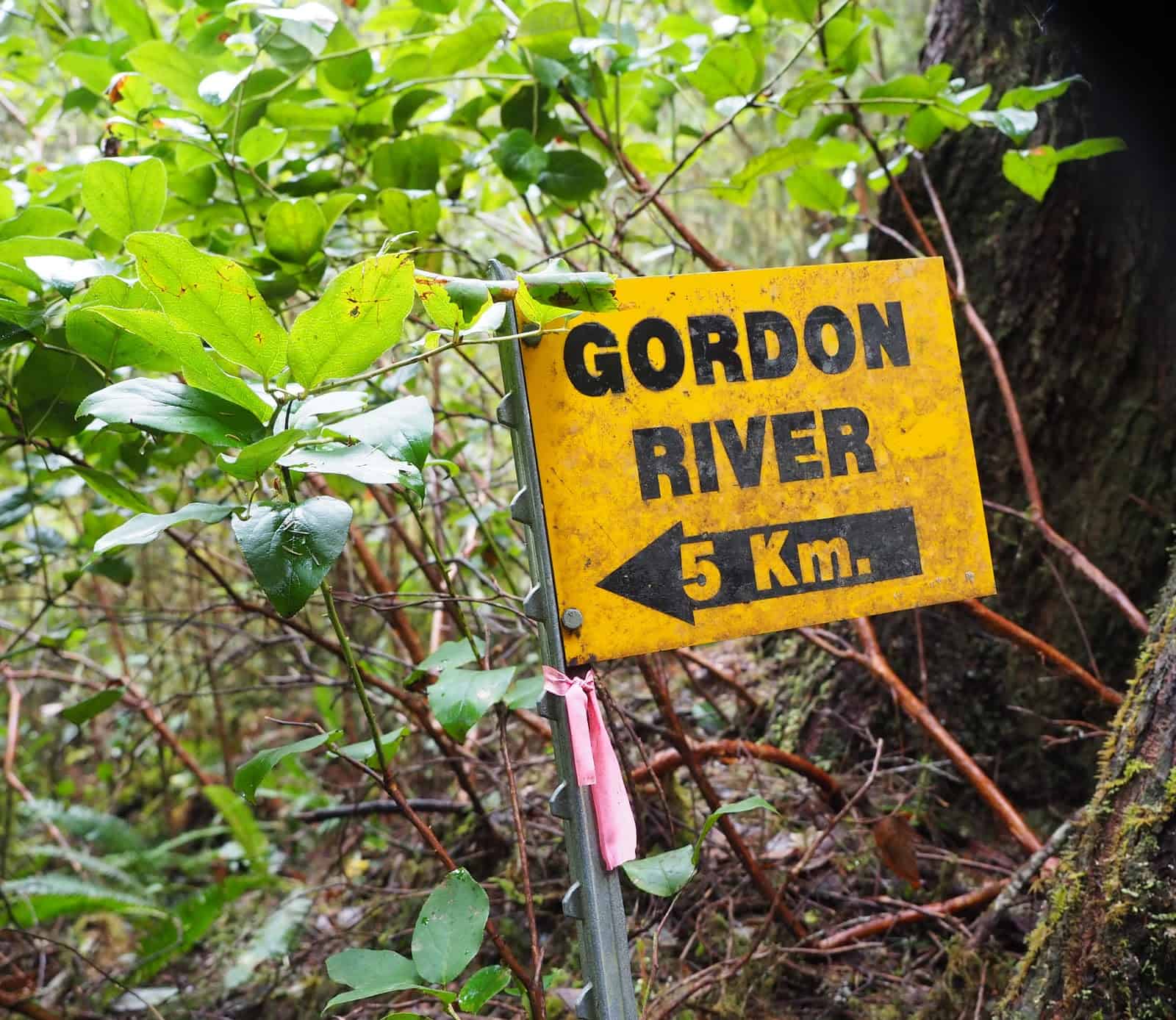
Above: A trail marker shows I am now five kilometers (3.1 miles) from the trailhead. It only took all day (six hours, give or take.) As a point of reference, earlier in the summer, I hiked 37 kilometers (22 miles) of a rough mountain trail in 14 hours.
A Place My Soul Calls Home
A final hard push down the trail to Thrashers Cove and the rainforest opens to a place that I have craved seeing for almost ten years.
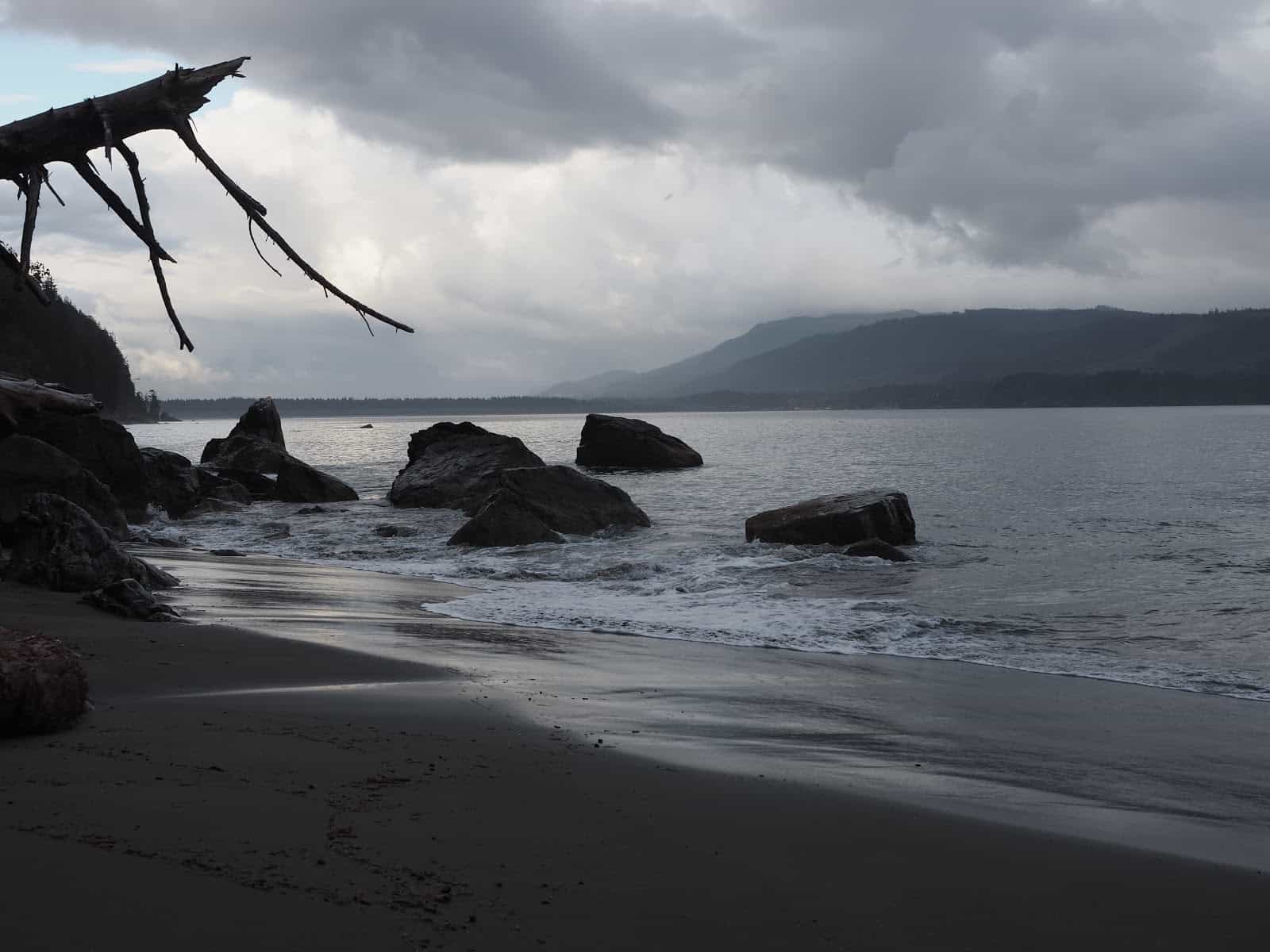
Above: I haven’t seen Thrashers Cove since my previous trip. For some reason, it was always my favorite. I have heard complaints of Thrashers Cove being crowded. In September, Thrashers Cove is almost empty, and it has a bohemian atmosphere. The other campers are quiet and respectful, and everyone has an optimistic outlook for the rest of the trail.
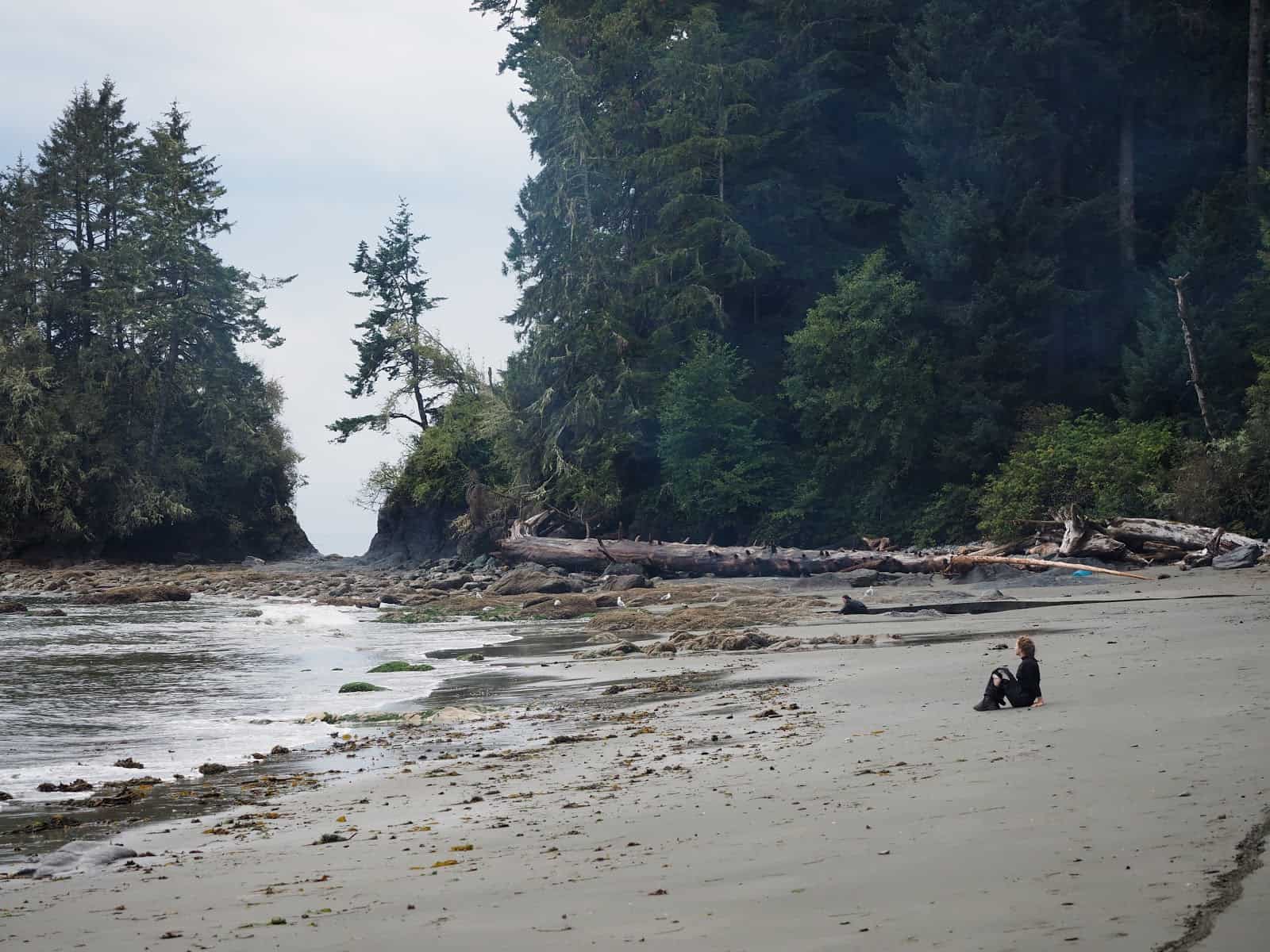
Above: Once my feet were firmly on the sand, my interest in dinner, water or any other immediate physical concern disappeared. I settled into quiet solitude until twilight enveloped me and an evening chill settled in.
Once I had lingered on the beach for a time, my companions and I set up tents, filtered water for the next day, made our meals and settled in for the night.
As darkness gathered, one of the hikers from further down the beach ran up. “So that you know, two cougars just crossed the beach by the bear box. They were following a solo hiker who just got in from Camper’s.”
Concern was readable on everyone’s face. I have the utmost respect for bears; they are honest and behaviorally consistent as a bear. Cougars are another matter; cougars are one beast I have no interest in meeting. I am thankful for my friends because cougars are uninterested in people in groups.
In spite of my fear of cougars, the sound of waves lulled me to sleep with morning adequately far off.
On the Trail Again
I woke up feeling refreshed and hearing the sound of rain on my tent fly. Rain this early in the morning does not bode well for my day of tidal shelf crossings, or visibility of the ocean for sea life watching. I wait as long as possible for the rain to stop. As it starts to slow, I bail out of my tent and make some coffee and oatmeal. Not long after breakfast, I shouldered my pack, and we headed down the beach.
My companions and I took the beach route across the tidal shelf. It’s slippery but one of the premier sights on the trail. Bouldering this section was my favorite day of my first trip in ’07. This section is also one of the most dangerous of the entire trail. Rogue waves, impassible headlands, and slick sea-scum-covered footing combined with incoming tides make this one of the most technical portions of the entire trail.
Everything Was Going All Right
After a kilometer of hiking along the beach, the sun was out in full force and the sea breeze was tugging at my strawberry curls. It was a perfect day for crossing the tidal shelf. Each footfall and handhold required a slip test and cautious placement. We climbed over boulders and through ocean gullies. Half the time this shelf is covered by the tide. Starfish, barnacles, urchins, and crabs were everywhere. If I didn’t know the tide would be coming in and covering the shelf, I could have spent hours examining all the little creatures.
All was going well until I slip-tested a gravel bed with my left foot. The footing seemed solid, but as I put my full weight on the gravel, it slipped sideways, dragging my foot and knee out from under me and jamming it underneath a boulder. I felt a sudden pop in my knee and felt excruciating pain. My foot was wedged underneath the boulder and my knee disjointed.
One Way Home or Drown
With a scream and pull with both hands, I popped my knee back in place and dislodged my foot. For a moment the pain stopped and my knee looked normal again.
Perhaps I hadn’t injured myself as badly as it looked?
I placed my weight back on my left leg and blinding pain rushed through my knee and straight to my brain. By the time my friends climbed to me, I knew I couldn’t go forward on the trail. Dread filled me as I realized that I had to go back.
The tide was coming in, and I certainly could not wait here and risk drowning.
Out of Options and Time
I tape, splint and medicate. As I dig through my first aid kit, I question its contents in the context of ultralight philosophy. However, today I have exactly what I need, even for a severe injury.
While one of my friends takes my pack, I use trekking poles as crutches and crawl over boulders on my hands and knees. From time to time, I accidentally put weight back on my knee and let out a blood-curdling scream. Occasionally, someone offers a hand or a shoulder through the gullies to help get me off the shelf before the tide comes in.
As we cross the shelf, we meet two of our fellow beach mates from the night before. I fill out the emergency evacuation card, and they compassionately wish me the best and promise to carry the card to the nearest radio station, two days ahead of them.
On the Run, an Inch at a Time
As my adrenaline wears off, pain is a constant companion. Light-headed and nauseous, but with my iron will intact, I inch along the shelf. In the back of my mind, I want to send my friends on ahead and make sure they are off the shelf before the tide comes in. Even if I asked, they wouldn’t leave me and if situations were reversed, I wouldn’t go on without them either. I always have said, when backpacking, go with people you can trust with your life. I have made a good choice in companions. To me they are heroes and with humility have refused to let me mention them by name. That will not stop me from getting sentimental and calling them out.
A Haven of Safety
Though I am inching along, I can finally see Thrashers Cove. I have seen Thrashers three times, and though I have always been happy to see it, I am overjoyed to see it now. A haven of safety. Once on the beach, my friends help me get into warm layers, set up a shelter and start a fire before heading into the rainforest to continue without me. They have missed the tide to go back toward the sea caves at Carmanah Point, and I can go no further.
There are several groups of hikers on the beach that will be spending the night. Several backpackers offer to look out for me while I wait for the evacuation crew from Parks Canada. A pair of gentleman heading down to Port Renfrew take my information and promise to get it to the radio station six hours ahead. Others on the beach, bring by chocolate and other hiker treasures and offer condolences. Anyone who has planned this trip knows the idea of not finishing is mildly devastating.
My Favorite Beach
Ironically, the beach I missed the most, is the beach I spend the rest of my day on the West Coast Trail.

Above: Storms blow overhead, but none decide to stay. I stay warm and dry and wait.
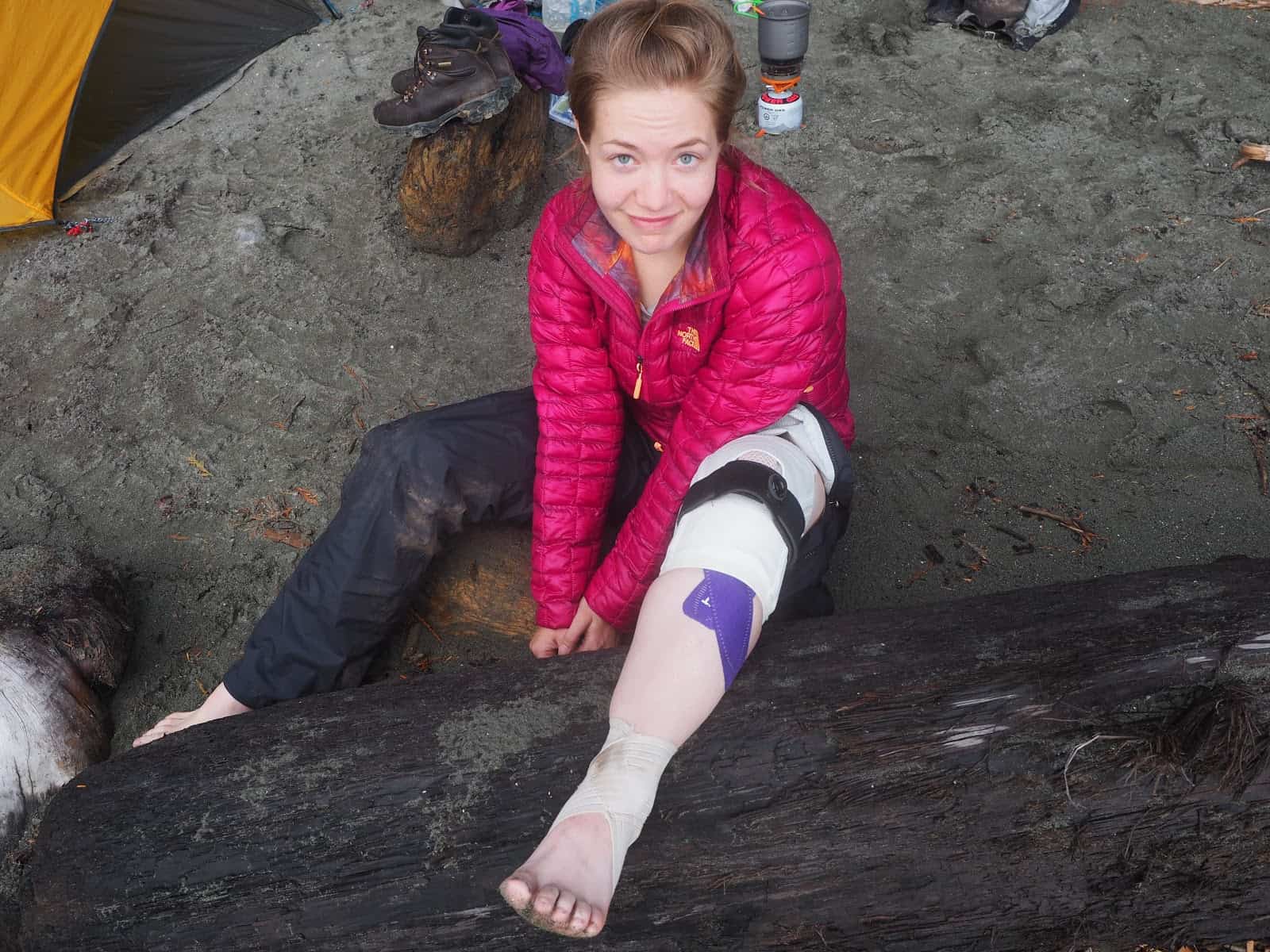
Above: I am grateful my doctor is an outdoorsman himself, he has been instrumental in giving me ideas of what things should be in my first aid kit. Pain management is crucial at this moment.
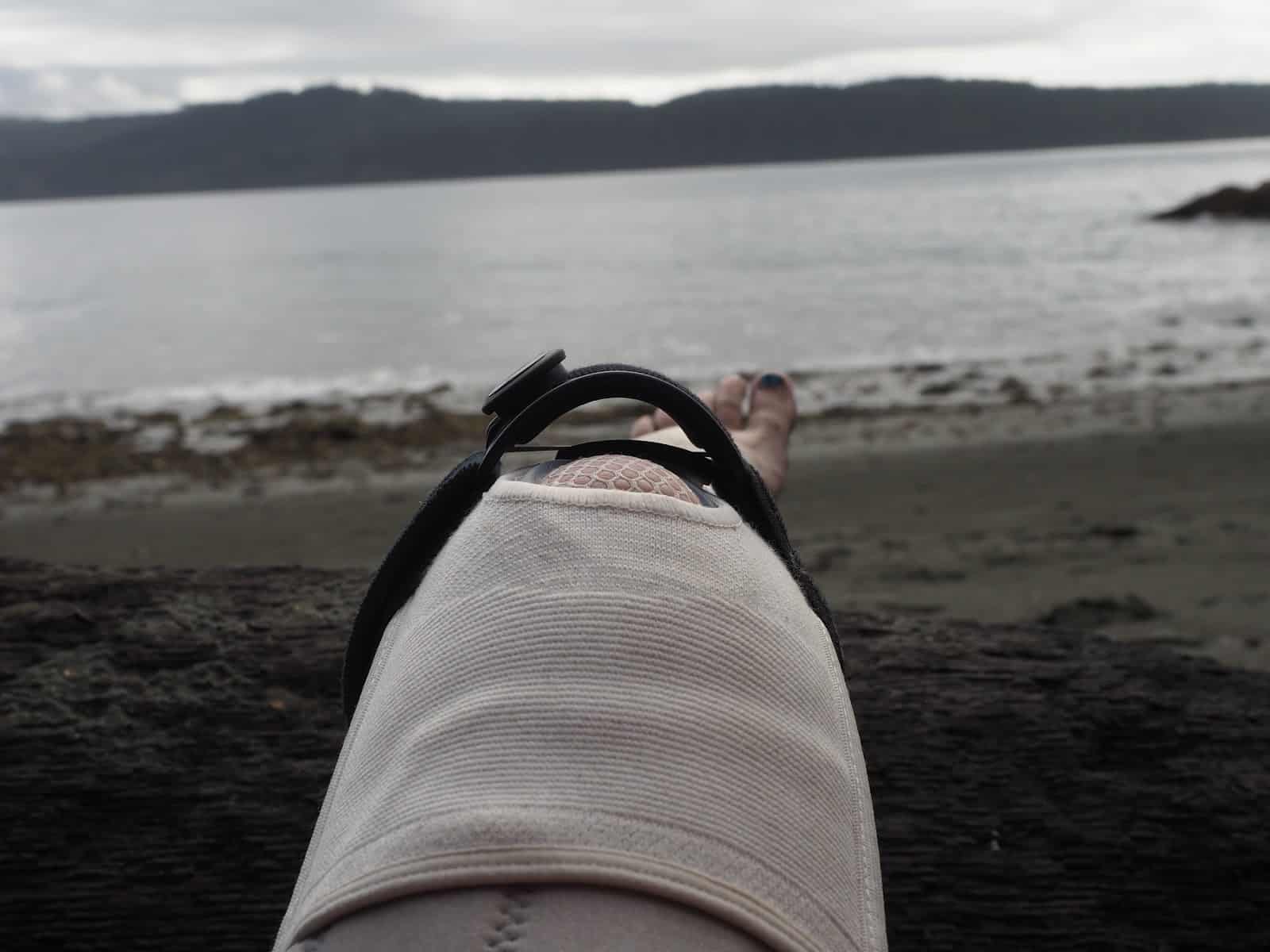
Above: Despite the swelling and pain in my knee, the view is still stunning.
Paramedics are Life Savers
After about five hours of sitting on the beach and enjoying the view, I am a little disappointed to see the Parks Canada Rescue Boat. It didn’t take the medics, Dave and Sebastien, long to find me. Suddenly, I find myself in a rather large crowd.
Dave sends everyone away to talk to me alone while he checks my pain level, and looks at my splinting job. “I couldn’t splint you better myself out here,” Dave laughs, “and what kind of painkillers did you say you had?” My doctor had given me some stronger NSAID’s in case my spinal injury caused trouble during the trip, but they seemed like a good idea on the beach when I was screaming bloody murder and racing the tide.
Dave continues, “I have two casualties on the beach, but I can only take one of you right now. You have the worst injury, (the other is a sprained ankle) but you are the best prepared to be out here if I don’t make it back tonight. The other thing is I think you should be taken by ambulance to Victoria hospital; it takes two hours for them to get to the dock. I’ll take the lady with the sprained ankle first and come back for you as soon as I can. I feel bad, but I think that is the best option for us both.”
And the Wait Continues
Personally, I do not feel bad about it. I have painkillers, a sunny beach, a fire and nowhere I need to be. My knee ligaments are either torn and/or my knee joint has dislocated. I am pretty sure it is torn, but I think I popped it back into the joint back on the shelf. What I know for sure is that my leg cannot bear weight. Left with no other choice, I wait and enjoy my little slice of beach.
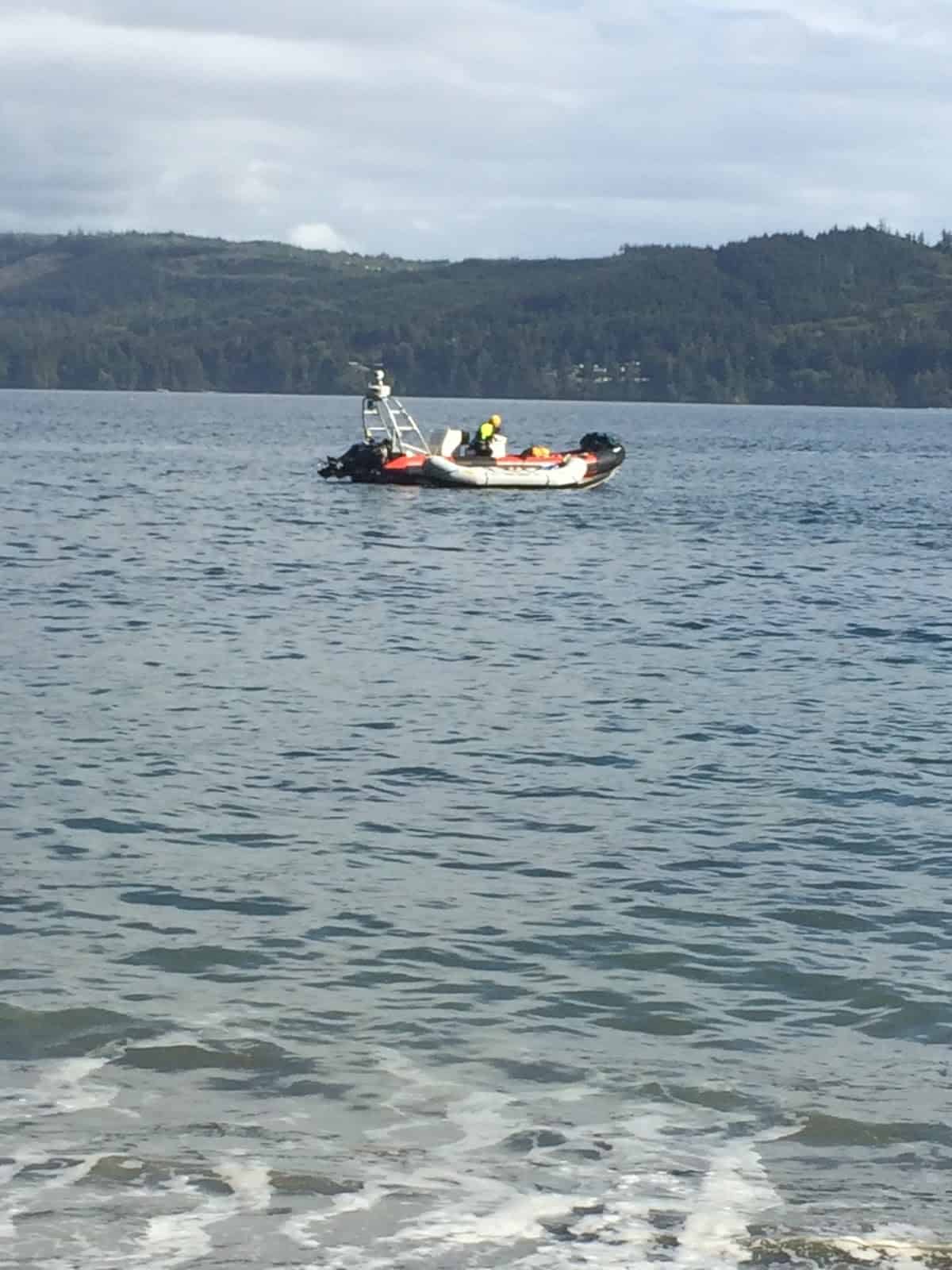
Above: Dave and Sebastien return for me in record time.
Dave practically has to carry me off the beach because my leg has gotten so stiff and sore. It is time to go for sure. The circulation is starting to get cut off in my leg but loosening my makeshift splint now is going to be excruciatingly painful. The medics whisk me across the bay in the Parks Canada Rescue boat, and I find two more paramedics (Aspen and William) waiting for me on the other side with a land ambulance.

Above: Once loaded inside and my splint removed, in seconds my knee swells to twice the size it should be.
Aspen advises me to take some anti-nausea medication if I have it. The ride is long and rough. I take her advice and am thankful again for my med kit. Several hours and another ambulance transfer later, I arrive at Victoria General Hospital.
A Night in the Hospital

Above: Alonzo is the nurse in the Emergency Room when I arrive. He makes sure I have a painkiller and that I am as comfortable as possible as I am whisked from the x-ray room to another room while waiting to see a doctor.
Near midnight, a doctor and two nurses arrive in my room. As the doctor examines my x-ray, he explains that my knee is in the right place, but some odd bruising around it looks like it was dislocated. His biggest concern is that my ligaments around my knee are likely torn, and when I get home I should have an MRI, physiotherapy and consult with a surgeon. For now, the doctor sends in the physiotherapist who wraps my knee and sizes me for crutches.
A Unique End to a Unique Journey
Once out of the hospital, I catch a cab to the nearest hotel, book two nights and try to get my bearings.
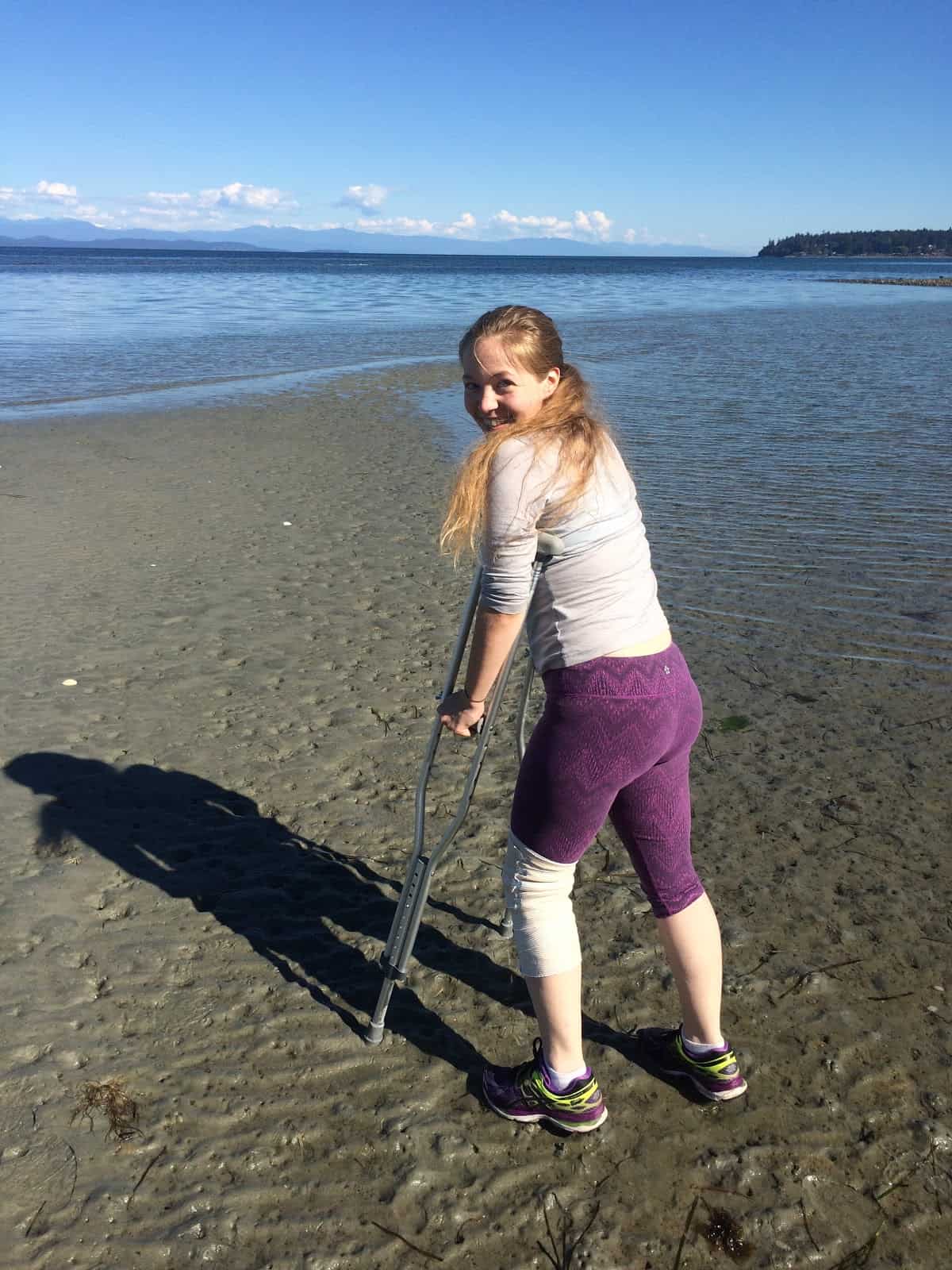
Above: After spending two days exploring Victoria, British Columbia, Canada on crutches, I find an Owner Direct room and a rental car and spend the remainder of my holiday reading a book, crutching down the beach and visiting friends in Qualicum Bay, British Columbia, Canada.
Finally, I catch my flight from Nanaimo, British Columbia and head back to Alberta. The MRI showed that I have a complex tear in my ACL, but I am off crutches and the knee is strong again. I will be meeting with a surgeon to discuss possible surgery and may make plans to see Thrashers Cove again in the future.
Gear Lists
Group Gear
| Item | Weight | Notes on Field Use |
|---|---|---|
| Nemo Equipment Blaze 2P Tent | 2 lbs, 5 oz (1.1 kg) | product in review |
| Woods Cypress Kettle | 9.1 oz (258 g) | |
| First Aid Kit | 9.9 oz ( 281g) | |
| Repair Kit | 7.6 oz ( 216 g) | |
| MSR Pocket Rocket | 2.9 oz (82.2 g) | |
| Silva Ranger Compass | 2.3 oz (65.2 g) | |
| Parks Canada West Coast Trail Map 2016 | 2.3 oz (65.2 g) | |
| SOL Mylar Blanket | 11.3oz (320g) | custom cut for Nemo Equipment Blaze 2P Tent |
Individual Gear
| Item | Weight | Notes on Field Use |
|---|---|---|
| Osprey Aura AG 50 L XS | 3 lbs 13 oz (1.7kg) | |
| Medium Exped Downmat UL 7 | 1 lbs 6 oz (623.7 g) | |
| Enlightened Equipment Prodigy | 26.50 oz (751.2 g) | |
| Platypus 1.8 Liter Big Zip Hydration System | 5.4 oz (153.1 g) | |
| Carbon Water Flavour Filter | 0.1 oz (2.8 g) | |
| 2 Mini Carabiners | 0.3 oz (8.5 g) | |
| Spork | 0.3 oz (8.5 g) | |
| Black Diamond Spot Headlamp | 3.3 oz (93.6 g) | |
| Black Diamond Women's Ultra Mountain FL Z-Poles 110 cm | 9.5 oz (269.3 g) | single pole only not carried |
| Cactus Creek Nylon 225g Bear Spray Holster | 1.4 oz (39g) | |
| Tru Flare Bear Banger Launcher | 1.3 oz (37g) | |
| Frontiersman Bear Spray 1% 225g Canister | 7.9 oz (225g) | consumable |
| Olympus OM-D E-M5 Mark II | 16.5 oz (469 g) | includes batteries |
| Olympus M. Zuiko Digital ED 12-40mm f/2.8 PRO Lens | 13.5 oz (382g) | |
| Joby Gorillapod | 1.6 oz (45.4 g) |
Layers
| Item | Weight | Notes on Field Use |
|---|---|---|
| Woman's Zamberlan Voiz GT Gore-Tex Backpacking Boots and Prescription Insoles | 3 lbs 4 oz (1.4 kg) | not carried |
| Outdoor Research Women's Verglas Gaiters | 6.5 oz (184.3 g) | not carried |
| Merino WrightSocks | 2 oz (56.7 g) | not carried |
| 2 Pairs of WrightSocks | 2.2 oz (62.6 g) | |
| MEC Hydrofoil Rain Pants | 9.3 oz (263.7 g) | |
| Purple Rain Adventure Skirt | 4.3 oz (121 g) | product in review not carried |
| IceBreaker Siren Bikini | 1.10 oz (31 g) | not carried |
| Seg’ments Merino Wool Base Layer | 4.8 oz (136.1 g) | not carried |
| Smart Wool Bra | 2.9 oz (82.2 g) | product in review not carried |
| Outdoor Research Womens Helium II Jacket | 5.1 oz (144.5 g) | |
| The NorthFace Thermoball Jacket | 7.9 oz (224g) | |
| Liner Gloves (synthetic dollar store mini mitts) | 0.8 oz (22.7 g) | |
| Outdoor Research Kensington Visor Beanie | 2.4 oz (67 g) | |
| Outdoor Research Echo Ubertube | .7 oz (20 g) | product in review |
Summary
A few weeks after the incident, Parks Canada Paramedic Dave calls me to see how I’m doing. According to Dave, it’s been a tough season on the trail. On top of a trio of rogue cougars stalking hikers and a habituated bear being too friendly at Thrashers Cove; the day Dave and Sebastien rescued me off the beach, there had been nine other evacuations. That’s about 10% of the yearly evacuations in a single day.
Dave tells me he is rescuing unprepared hikers daily. Unfortunately, he thinks it’s a trend. The more popular the trail becomes, the more inexperienced hikers attempt it. Dave tells me my evacuation was shockingly well-equipped and more organized than others this year. Not only did I have the right tools to treat a fairly significant injury, but I had also managed my pain and prevented shock. In Dave’s experience as a rescue medic with Parks Canada, he notes that many hikers are either physically unequipped or mentally unprepared to handle a medical evacuation.
Ultralight hikers can’t afford to be unprepared at the expense of saving weight. Preparation is not only the act of packing a first aid kit but mentally memorizing each item in it, where it is and imagining all its possible uses. Practicing “what if” scenarios can help us mentally and physically prepare for emergencies. Talking to medical professionals, who share outdoor enthusiasm, about useful items in a wilderness first aid kit can make a meaningful difference.
Special Thanks
It’s been more than a year since I set foot on the West Coast Trail. While I do regret tearing my ACL and not putting on my crampons, I do not regret attempting this hike. I also do not regret a single ounce I had in my first aid kit as I used almost all of it. I’m grateful for the Parks Canada Staff, the BC Emergency Medical Team and the marvelous doctors, nurses and staff at Victoria General Hospital. Lastly, I’m grateful for good friends, who wouldn’t leave me behind.
Though I’m half convinced the trail spirit is trying to kill me, I’m currently trying to decide if I will book the West Coast Trail again in 2018.
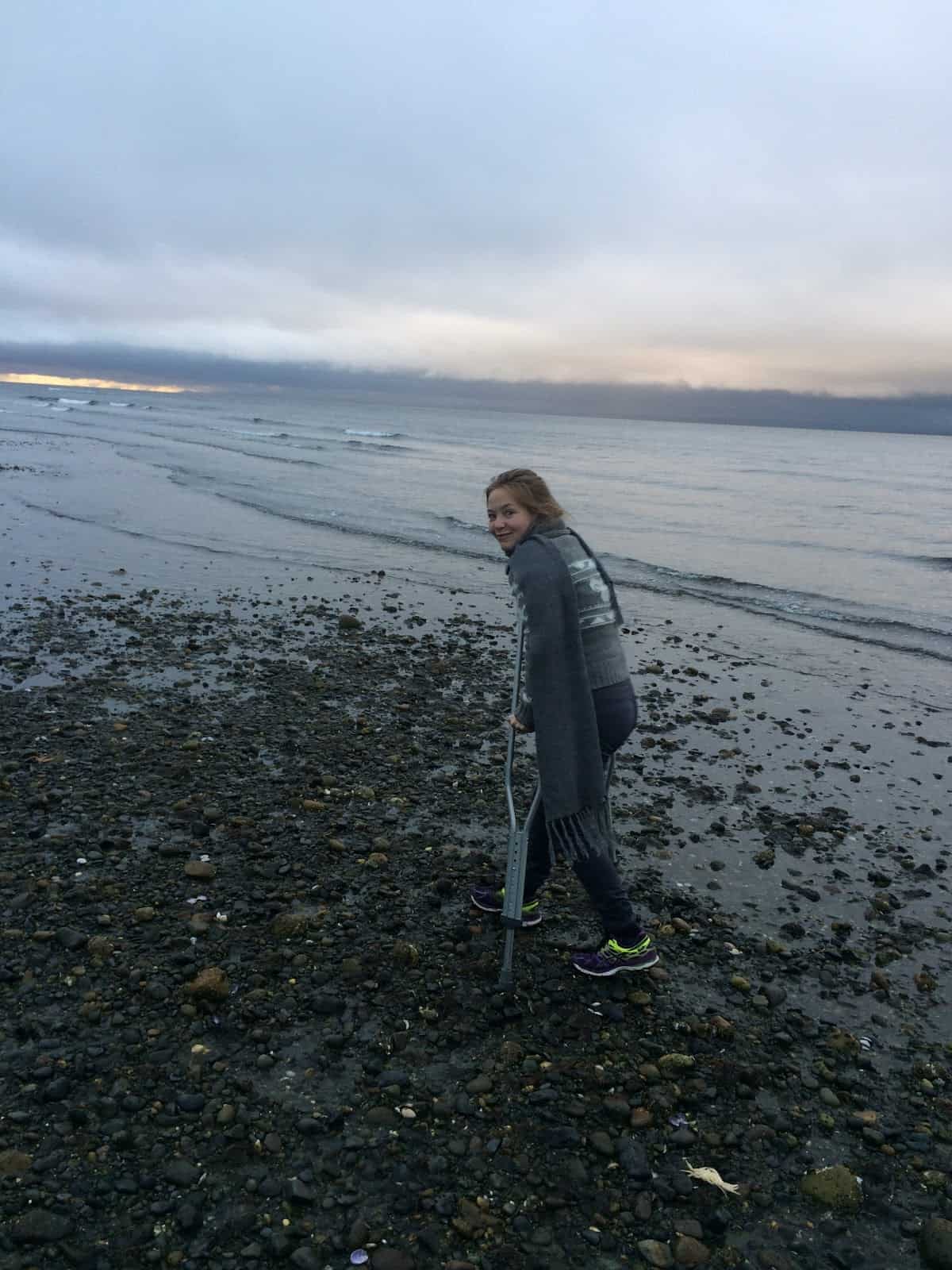

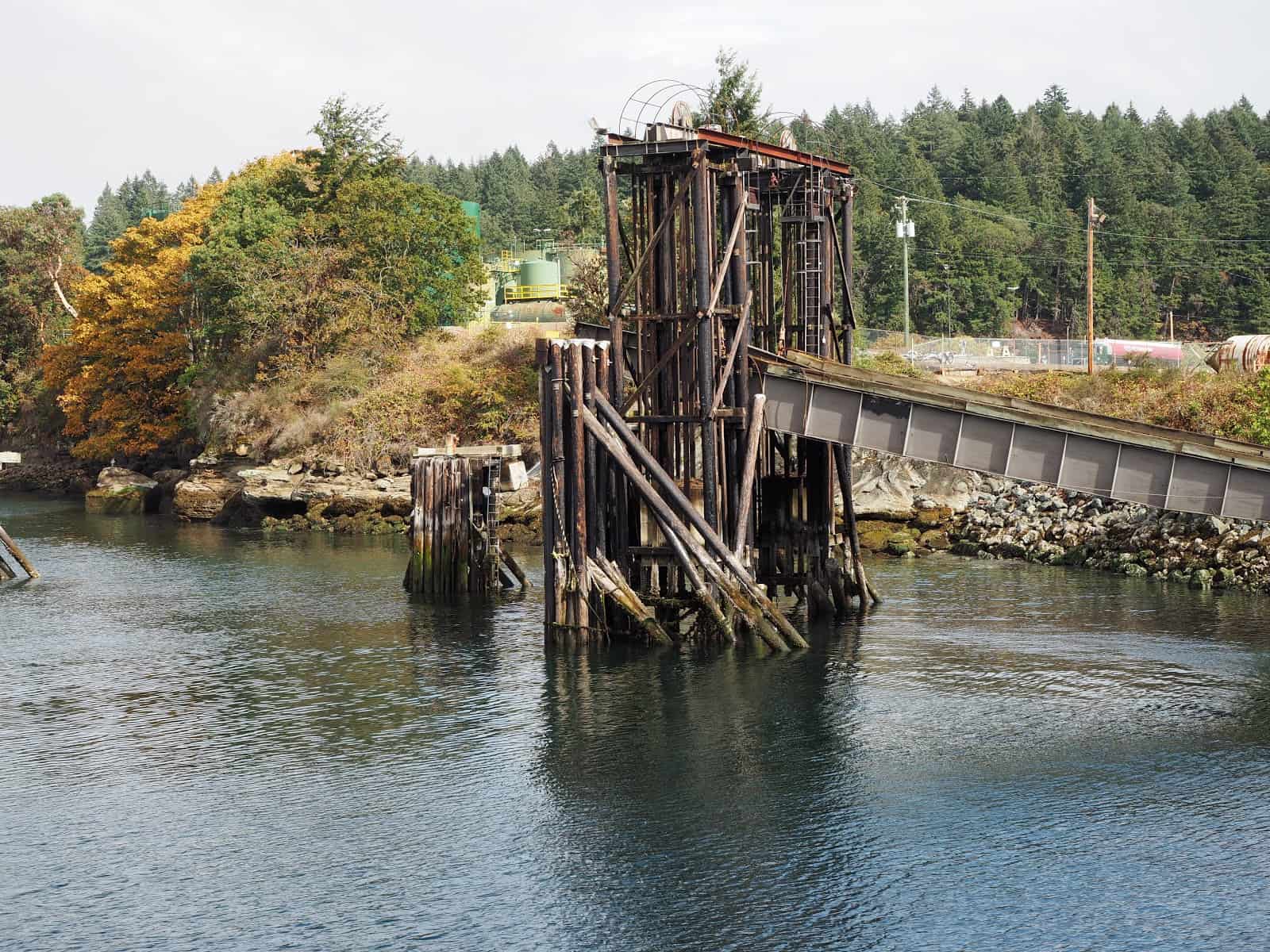


Home › Forums › Vancouver Island: Trauma on a West Coast Trail Backpacking Trip